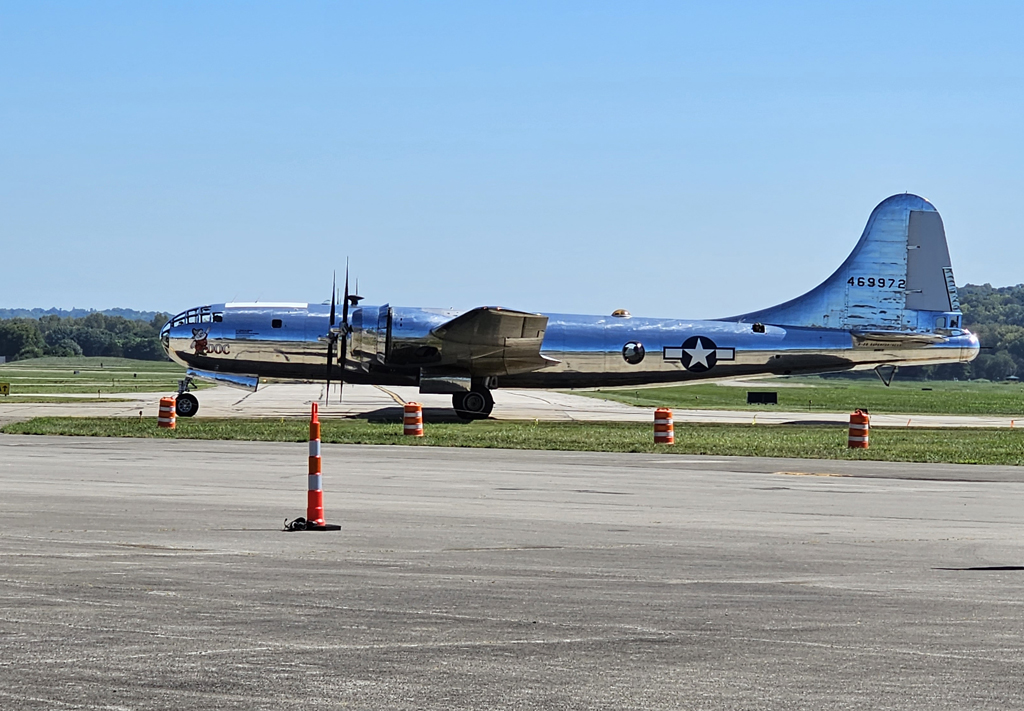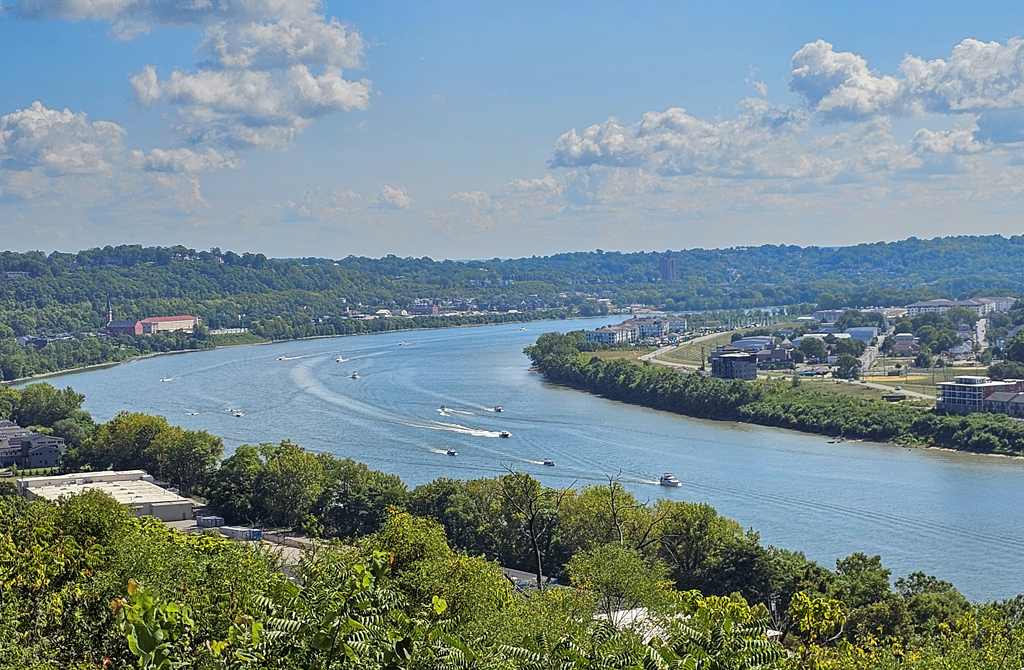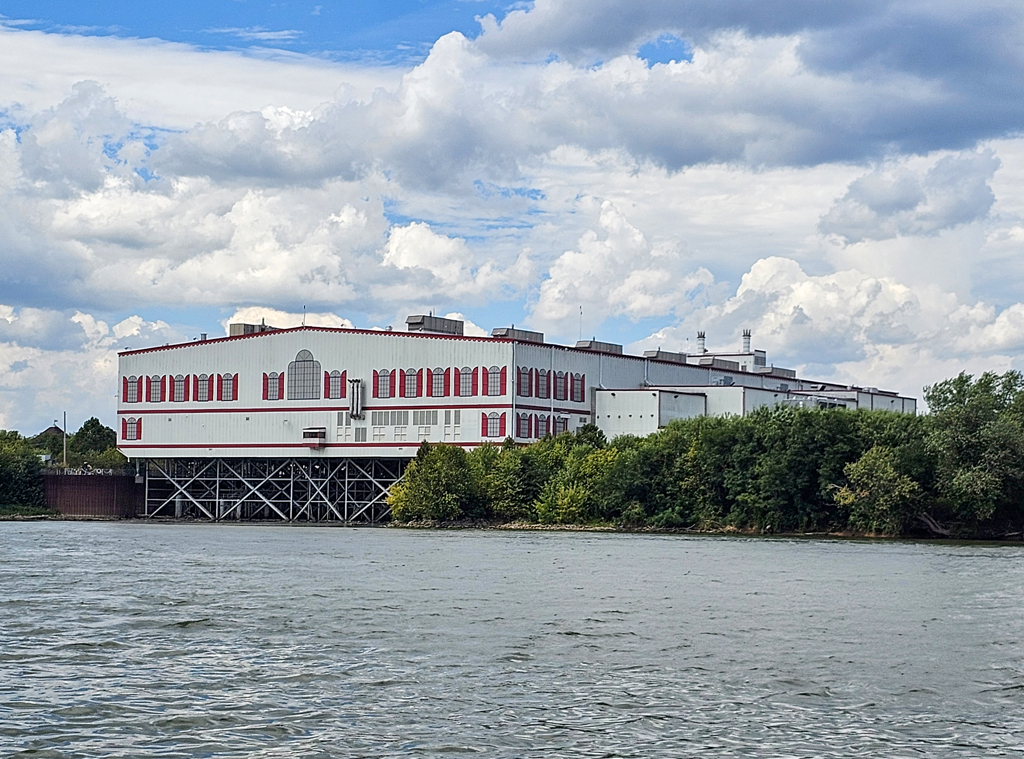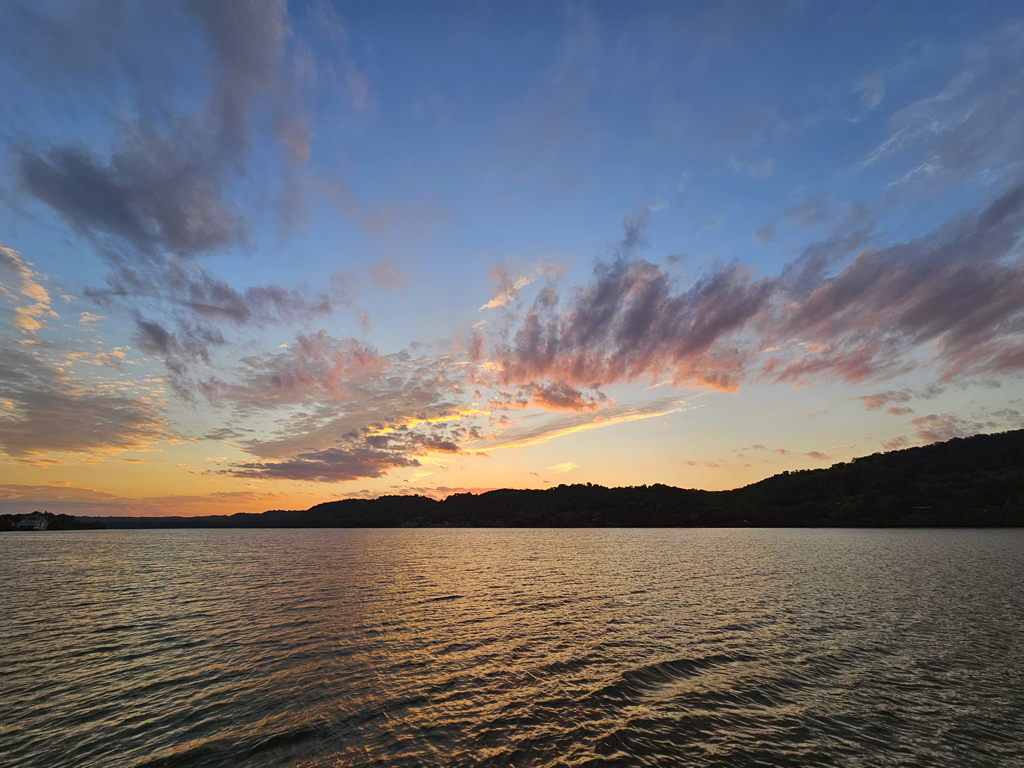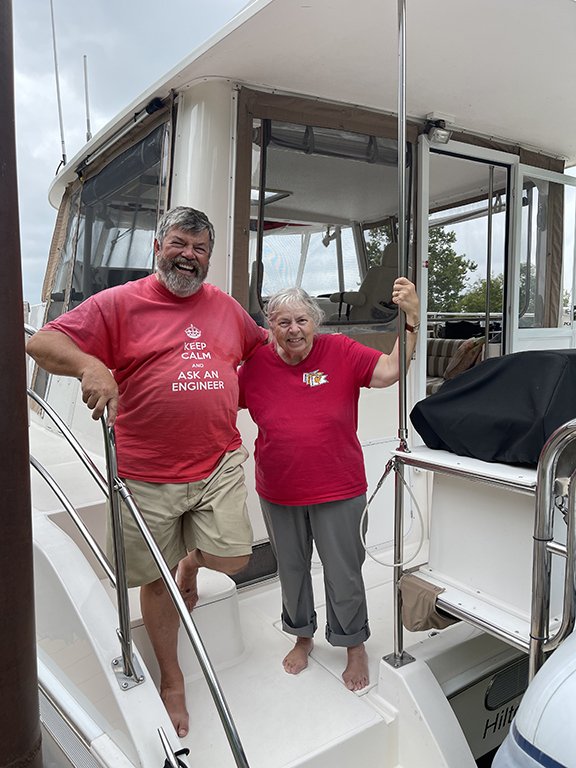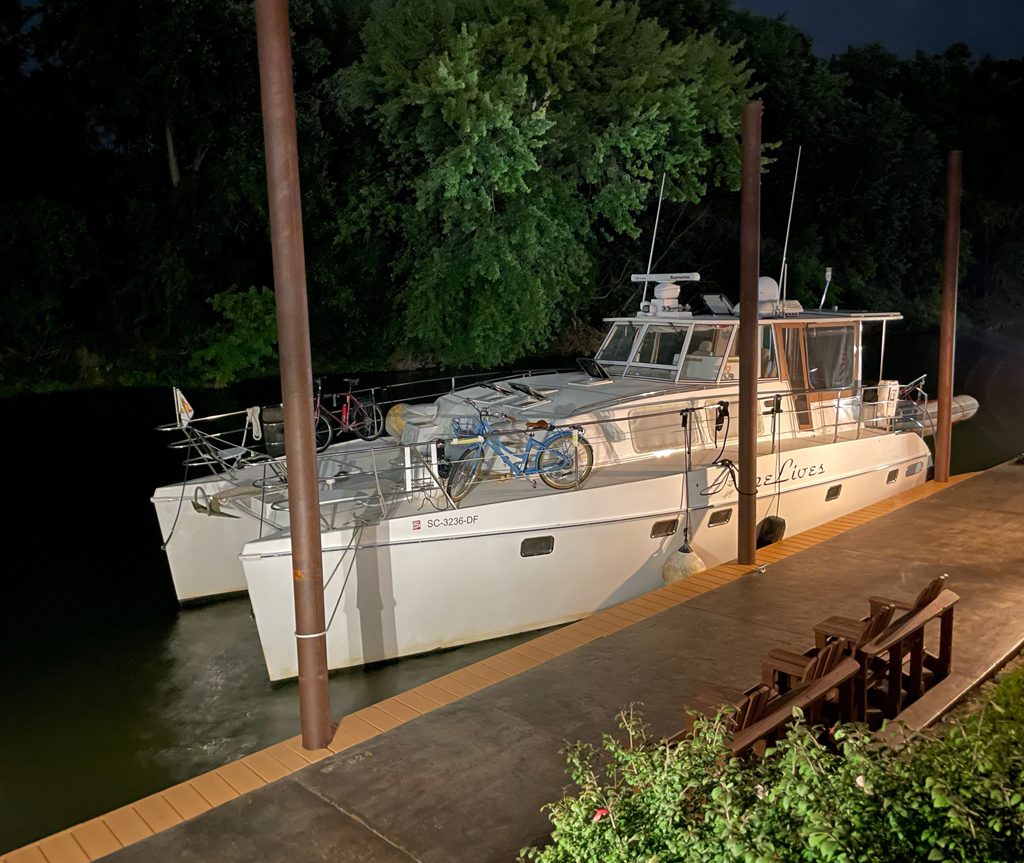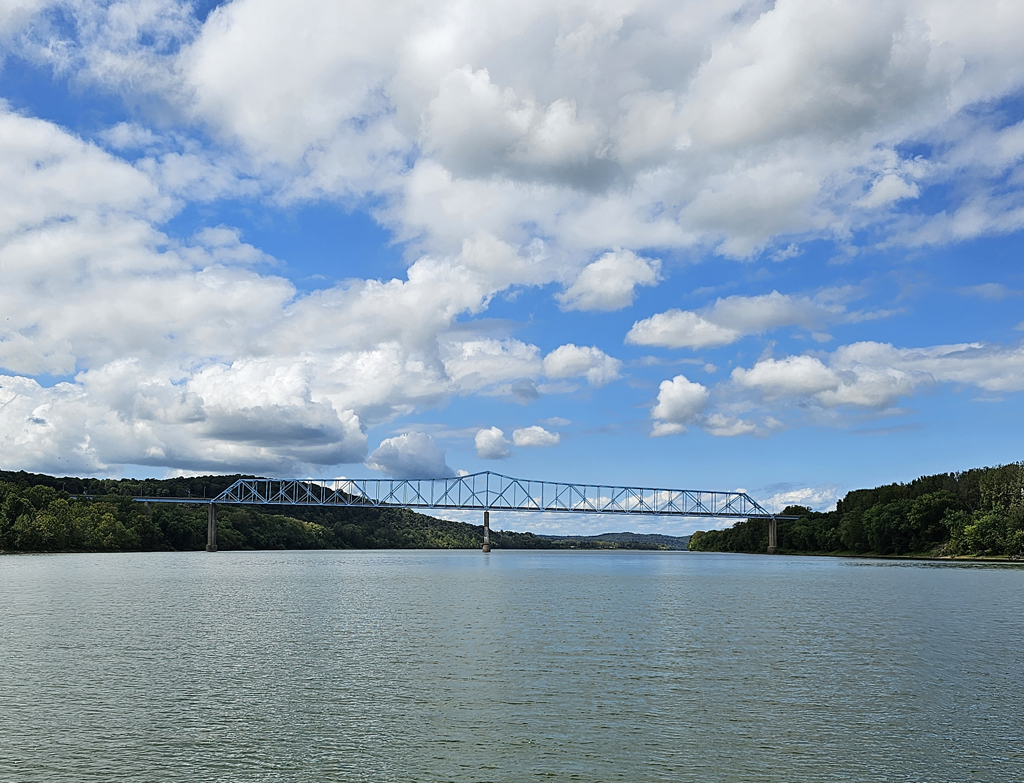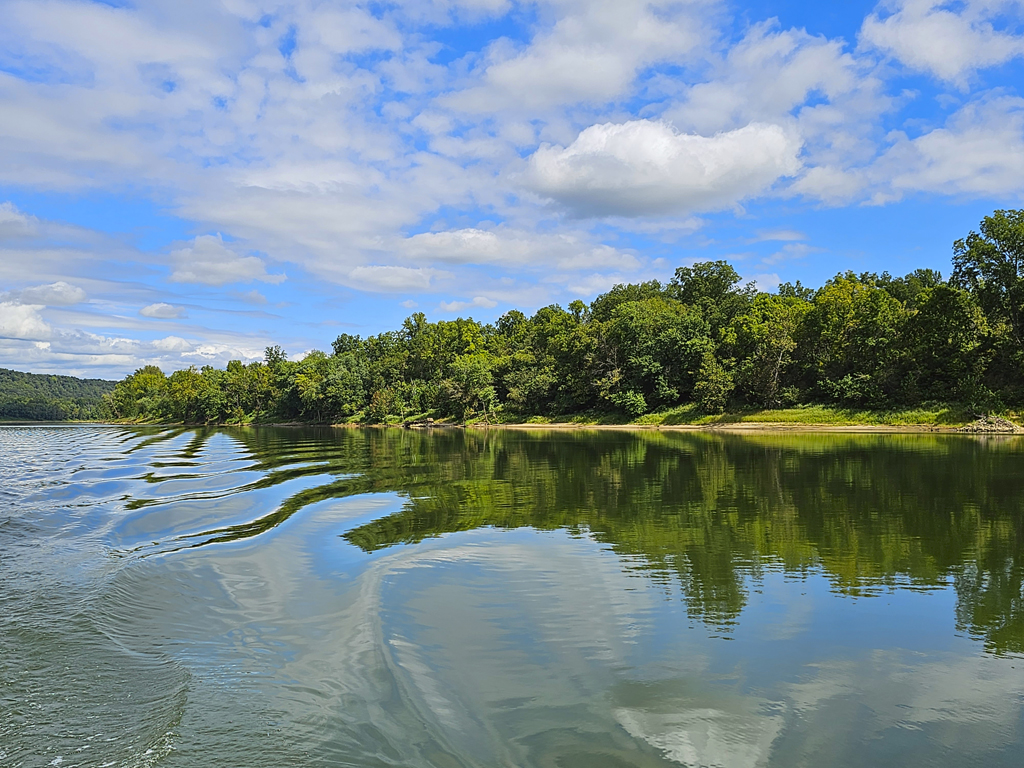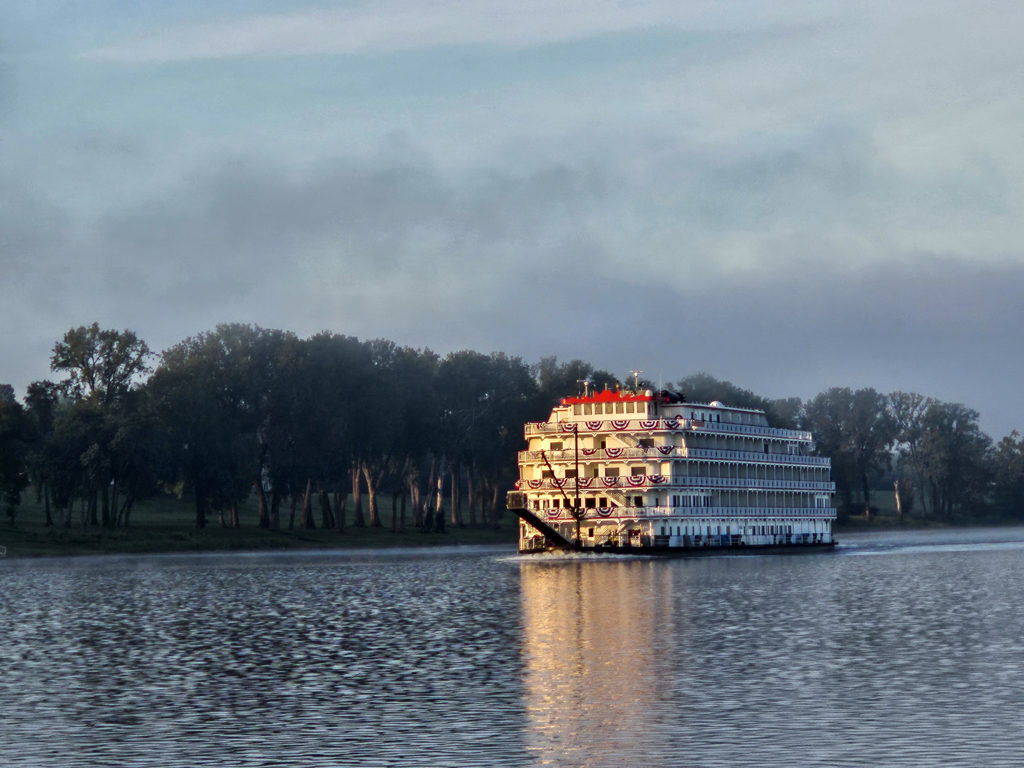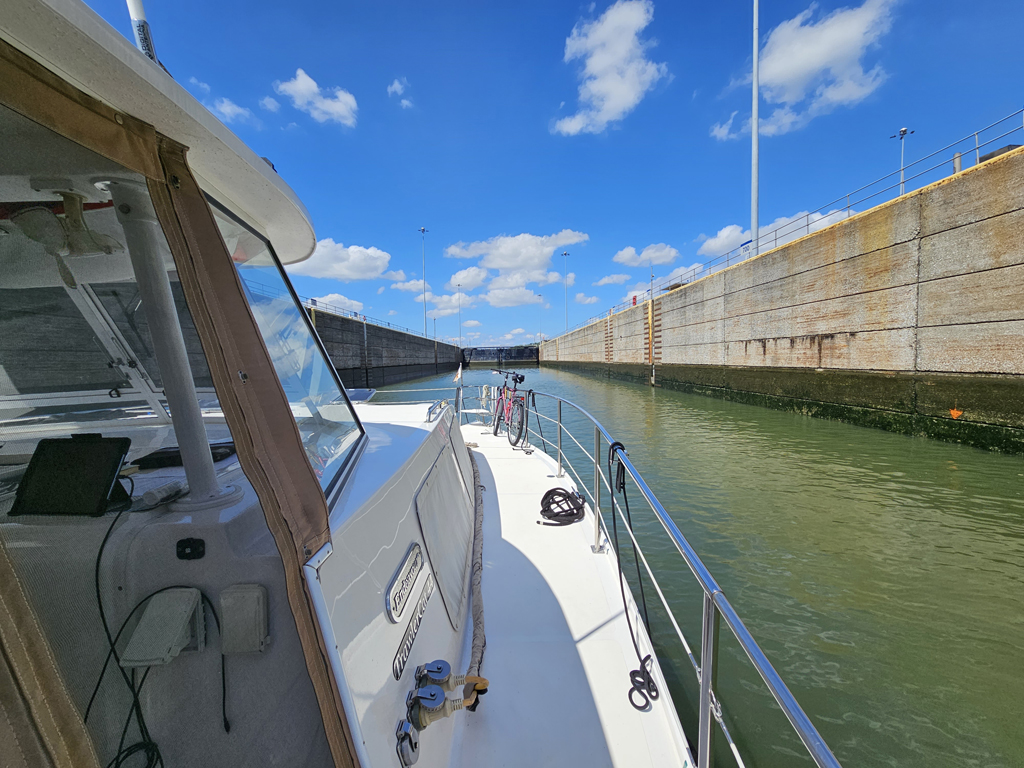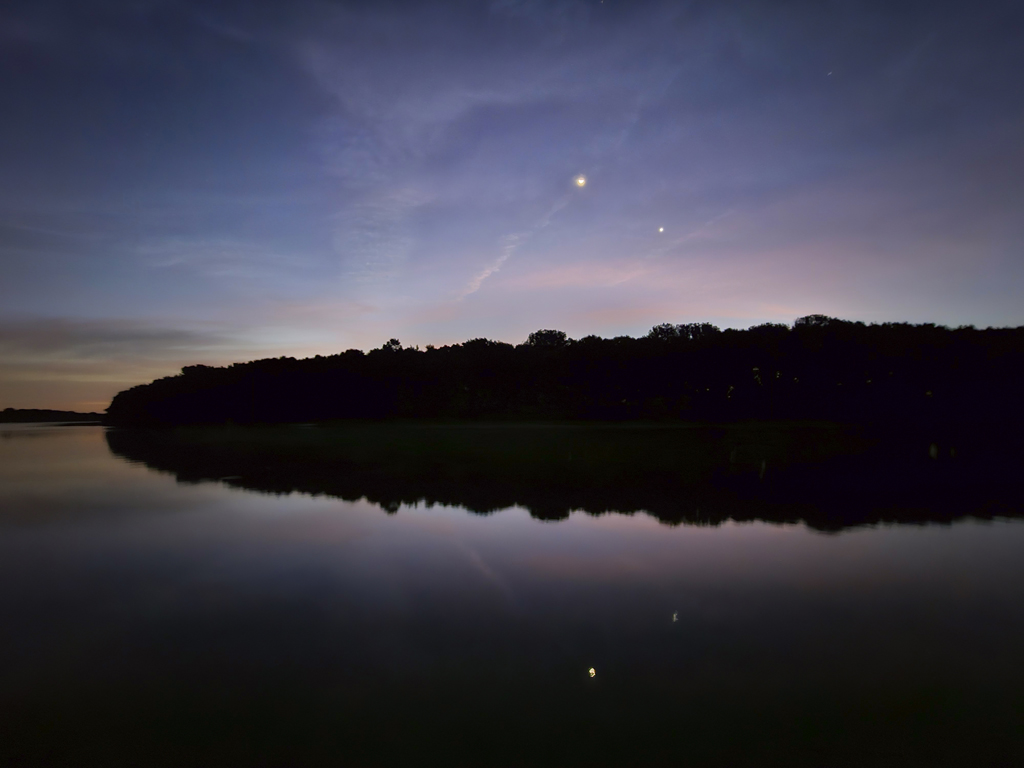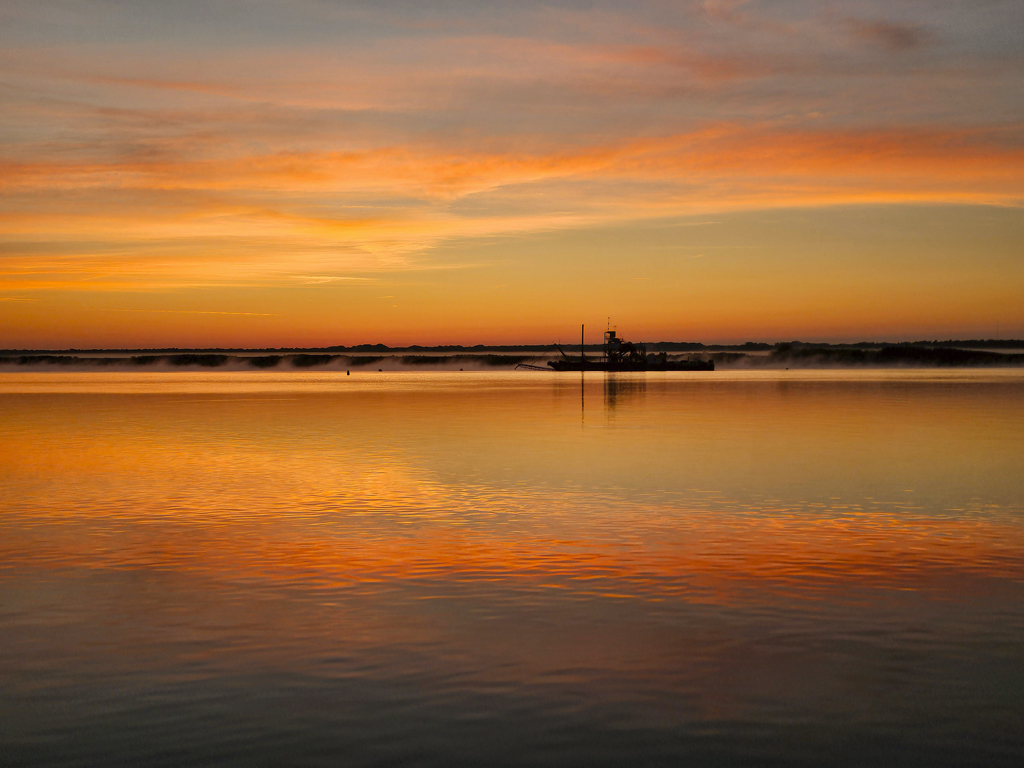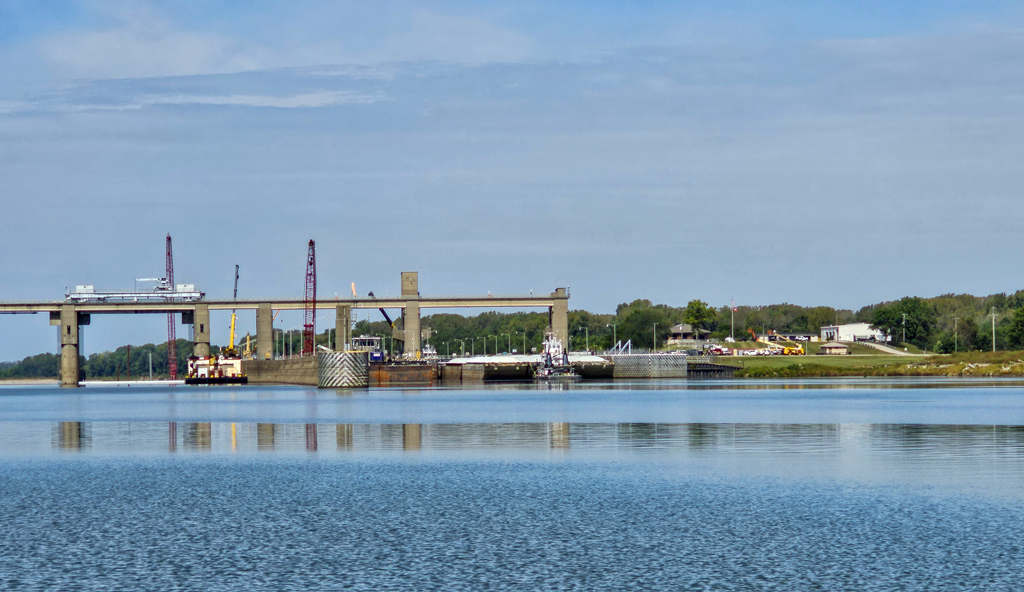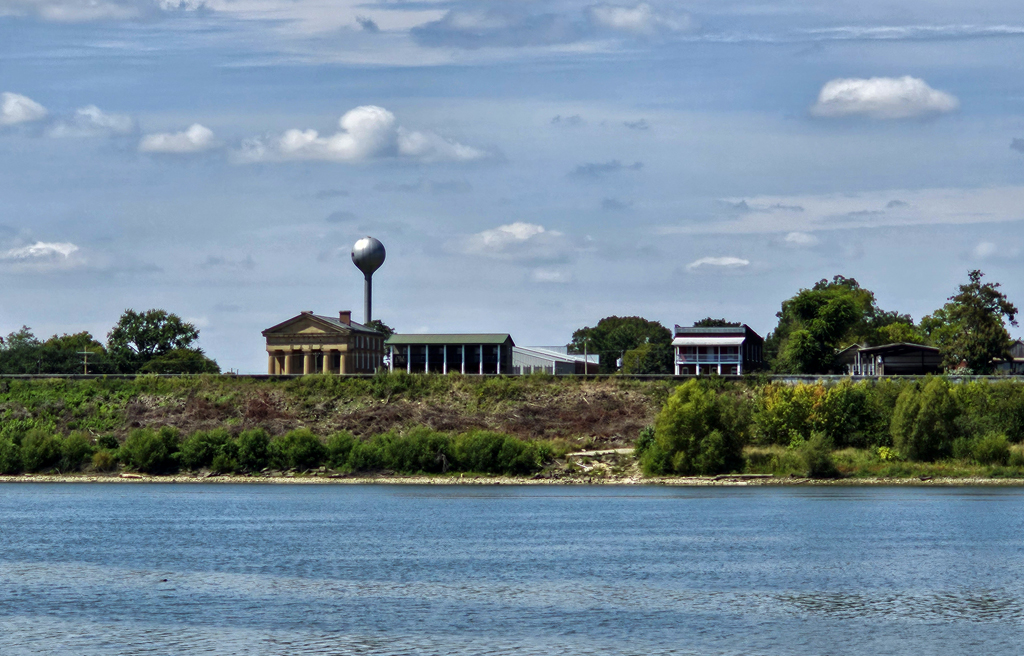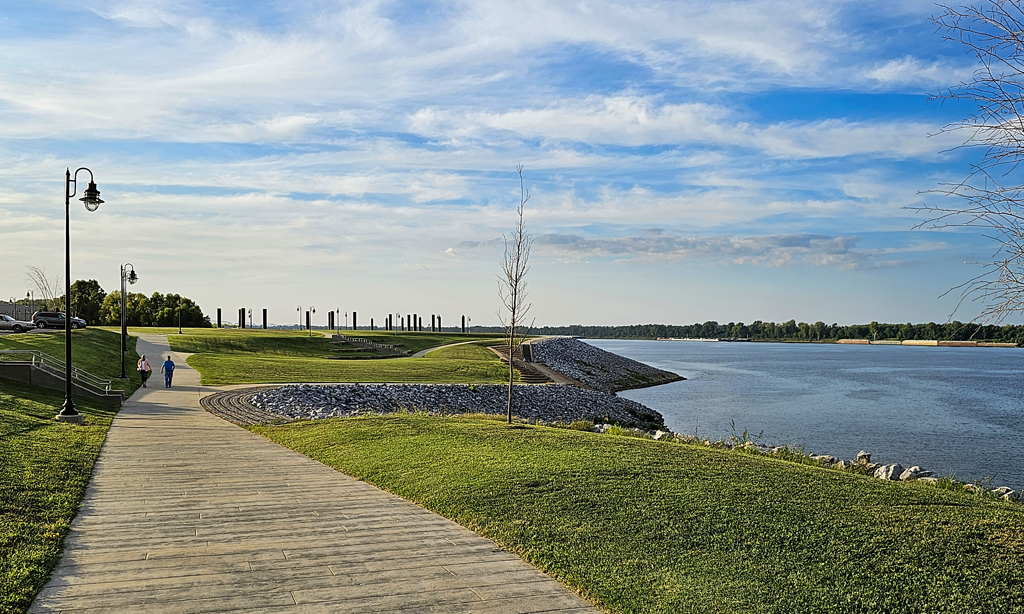On our last afternoon in Paducah, Dick did what we expect will be our last major grocery shop for this trip. In bygone days, the hunter gatherer would have joined a bison hunt, but today, he leaps onto his trusty steed and rides (40 blocks in each direction, uphill both ways of course), to a supermarket where he loads up provisions for the autumn. No bison, so he bought eggs, bread, milk, and other essentials like beer and coffee.

Our tasting menu on our last evening in Paducah at Freight House was everything we could hope for. The 8-course menu was incredibly creative, and the blend of flavours in each dish was exceptional. It is certainly what we would expect from a named chef. They do seem to have upped their game since we visited last spring, adding comfortable chairs, and I think a little more neutral decorating, while still retaining the old freight house ambiance. What amused us, being quite familiar with 6 and 7-course tasting menus in UK, was the size of each portion. They were easily double, and even triple the size they would be in UK. What was particularly interesting was that there were very few dishes on their menu, that either of us would have ordered. The great thing about a tasting menu is that you try things that you would not normally choose. Neither of us likes cold soup or pumpkin, and yet what we had was delicious and we would order it again. Same with the ribs. Although Dick does order ribs, I won’t touch them, and yet I thoroughly enjoyed the dry rib style with a crunchy topping and almost no fat. The excellence and innovation continued through all 8 courses. We even had the wine pairings, and they were perfectly chosen to complement the dishes. One thing we laughed about was the pours of the wines. In every case, the waitress poured Dick’s glass first, and then put more into my glass that his! If we ever return to Paducah, we will certainly eat there again.
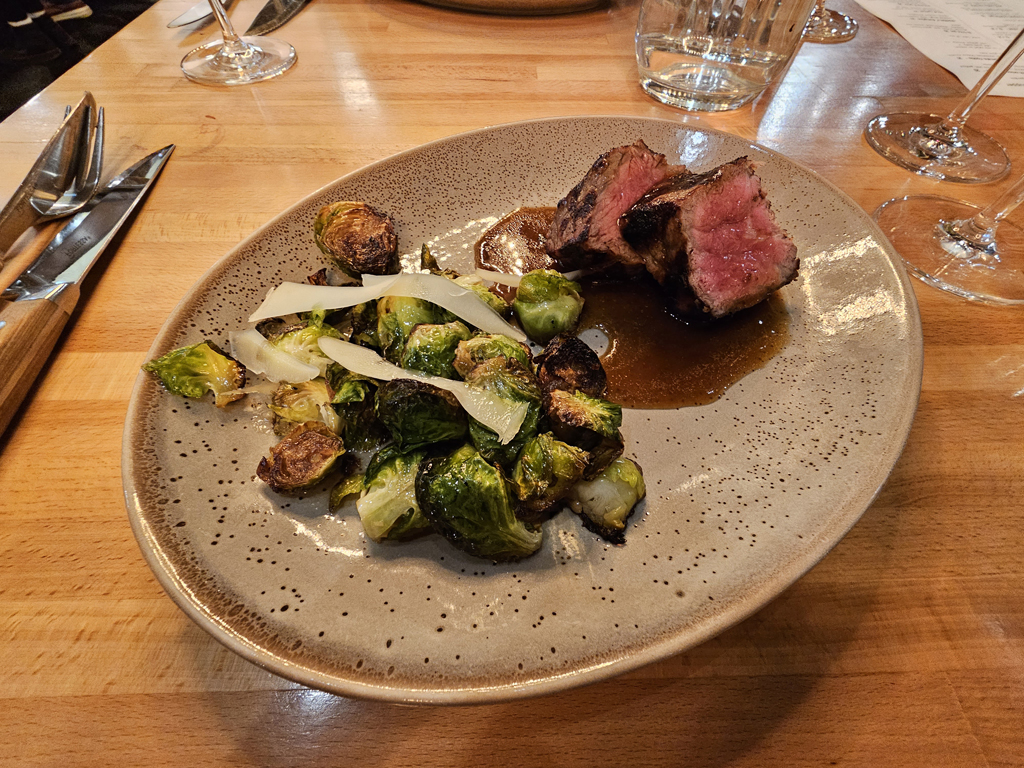
The next morning, we were very glad to see the dock attendant had received the message Dick left the evening before, and he arrived 15 minutes before the department even opened to give us fuel and a pump out. Dick had checked prices, and on this occasion, diesel was cheaper at Paducah than at Green Turtle Bay, even with the discounts they offer. He also did not charge us for the pump out. We had a very interesting conversation with the dock attendant about food and fine dining restaurants. Just shows that one should never make assumptions.
Filled up and pumped out, we were on our way by 9:05. Sadly, after a mile, we had to return to the dock to collect the credit card we had forgotten to get back from the attendant, so our actual start time was more like 9:30.

We had hoped to go up the Tennessee River and through Kentucky Lock for a change, and the queue reports for Kentucky Lock and Dam had been very positive earlier in the week. Unfortunately for that plan, normal traffic on the Ohio River had resumed, so the usual 4 and 5 tow delays were back. We went up the Cumberland River instead (our 5th transit), which is farther, but quicker, to our destination at Green Turtle Bay.
Now that we are off the Ohio, we are seeing wildlife again. There were some birds on the lower reaches of the Cumberland, but Barclay Lock was a treat. Perched in the lock doors were a green heron, a night heron, and a great egret. On the lock wall, a great blue heron kept watch. On the lamp posts, there were seagulls, cormorants, and a bald eagle.
We were tied up in Green Turtle Bay by 3:20. It was an interesting arrival. The dockhand, an older man, came to help, so I passed him the midships line and went to the bow to let Dick know how far to come into the 20 foot wide slip. I could not understand why he kept steering to the right, and Dick couldn’t understand why he wasn’t making any forward progress. I looked back, and the dockhand had cleated the midships line and was dragging us sideways and backwards for all he was worth! Once I asked him to let go and uncleat, all was well.
For the first time in 4 visits to Green Turtle Bay, the Yacht Club dining room was open. It is a considerable step up from most yacht clubs we have visited, more like a fine dining restaurant. Shrimp cocktail for me, and an unusual wedge salad made with romaine lettuce was Dick’s choice to start. Dick had grilled catfish, and I enjoyed a perfectly cooked filet steak. Dessert was salted caramel cheesecake for me, and ice cream for Dick. It was an excellent meal, and we will look forward to visiting again on our return from Nashville.


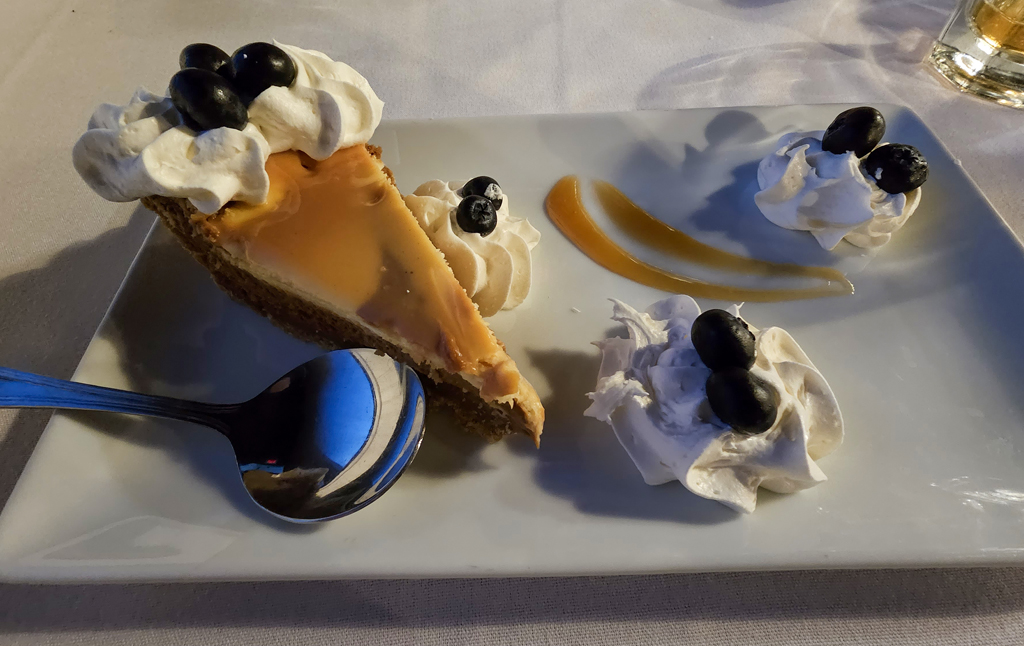
We were in no rush in the morning, had time to chat with several Loopers on the docks before heading out by 9:20, with new territory ahead!
We passed a tow that had one barge on his hip (that is, tied to the side of the tow, rather than being pushed with the rest). I don’t recall seeing that before.

Further along the Cumberland River, we passed the Kentucky State Penitentiary, known as “The Castle on the Cumberland”. It is Kentucky’s only maximum security and supermax prison. The main building was completed in 1888, built of stone from local quarries by Italian stonemasons. A later, fairly sympathetic addition on the right-hand side, was built in the 1930’s as a New Deal project. Inmates are not sent there directly from sentencing, but rather they are transferred there because of violent or disruptive behaviour in other prisons. It is also the site of Kentucky’s death row and execution facility. In 1988, 8 convicts, including 3 on death row, escaped by cutting through cell bars, walking through cell-house doors, and climbing 30 feet to a window using an electrical extension cord. More than 160 prisoners have been executed there. The penitentiary is said to be haunted, hardly surprising.

After 3 months on the Ohio River with very little to photograph in terms of scenery and wildlife, the Cumberland is heaven for me. I brought my big camera up from below for the first time this trip, and had a wonderful day. Herons are so much bigger than on the Ohio (pollution stunts growth perhaps?) We saw pelicans in rafts, literally hundreds of great egrets, and the usual cormorants, turkey vultures, and ducks.




We arrived at Bumpus Marina, a very rustic store/fuel dock with covered slips for seasonal renters. The very friendly dockhand helped us squeeze into our spot, and admired Nine Lives. He reminisced about his own catamaran that he used to keep in Florida. Nine Lives looked rather like an aging diva squeezed into a dress that no longer fits!

I made pizza on board, starting the dough while we were underway. It rose beautifully in the warm cabin over the running engine with the door shut. Afterwards, we sat in the cockpit and watched the fishermen returning to the launch ramp at dusk.

In 1862, Union troops moved a fleet of 4 ironclad ships, 2 timber-clad ships, tugs, transports, and hospital boats up the Cumberland River to attack Fort Donelson. The Confederates defending the fort badly damaged the fleet, but Union forces eventually encircled the fort and forced 13,000 Confederate troops to surrender. Although a sortie was led to clear the way for the Confederates to evacuate to Nashville, a combination of cowardice, self-interest, incompetence, and a misguided assumption that Ulysses S. Grant would offer generous terms to a former friend, led to the two senior generals escaping with a few soldiers, leaving the remaining troops to surrender. Grant refused to offer terms, gaining the nickname “Unconditional Surrender Grant”, and elevating him from an obscure and unproven leader to the rank of major general. The battle and subsequent surrender resulted in most of Kentucky and much of Tennessee, including Nashville, falling under Union control.
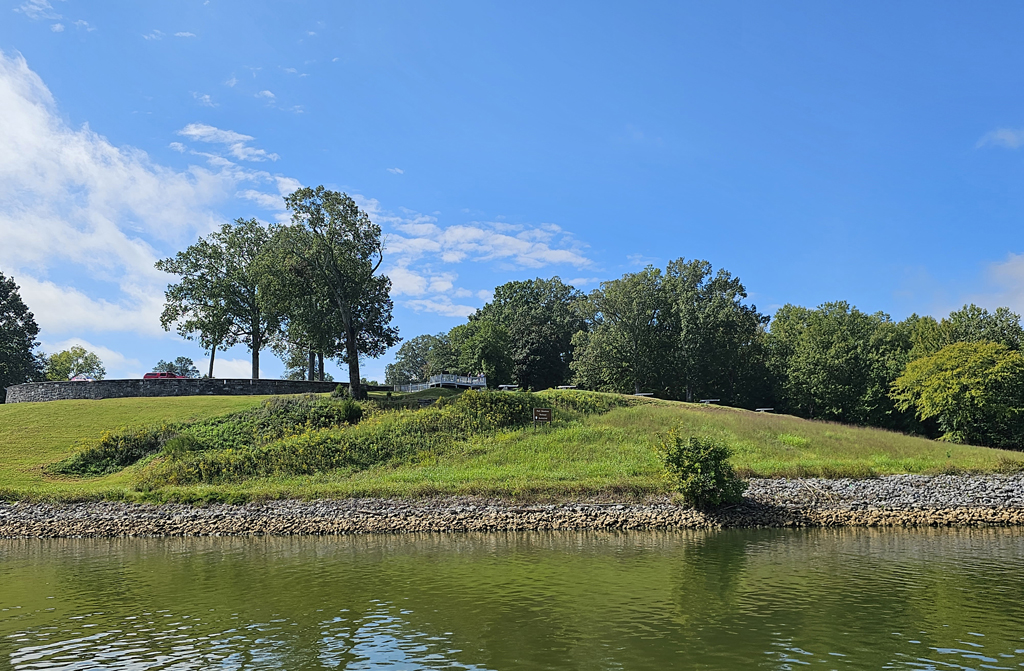
We passed the Cumberland Steam Plant. It was one of the world’s largest when it started operations in 1973. The striped stacks are 1000 feet high, thought at the time to be high enough to disperse furnace gases safely. They are no longer used, as newer 600-foot stacks with scrubbers remove impurities before the gases are released. The tall stacks will not be removed. The suggestion is that they remain as a landmark and historical artifact, but being somewhat cynical, I suspect that bringing them down would be pretty much impossible without damaging the rest of the plant.


Millions of years ago, a giant meteorite struck the earth here. Horizontal layers of stone from up to 2000 feet below the surface were thrown up into vertical layers. The steam plant is thought to sit at the centre of the impact.

Just below Clarksville, we came across another Endeavourcat. Two Hull-Areas is a 36, so a little smaller than Nine Lives. It is always interesting to see the similarities and differences between models and manufacturing years.
We passed American Melody again, after seeing her in Paducah, docked that day in Clarksville.

We tied up at the marina by 3:20.
There is a large grill-type restaurant at the marina, so we decided to try it. The beer cheese with pretzels and taco chips was very tasty, but the cheese was also very thin, so it dripped everywhere no matter how careful you were, and clothes had to be consigned to the laundry basket on our return to the boat. The rest of the meal (burger, wings, chicken wrap), was fine but nothing special. Service was very slow. We are back in Tennessee, so we were carded for drinks orders, which irritates me far beyond the minor inconvenience!

Later, we enjoyed a nightcap with Gina and Roger from Two Hull-Areas, who are based in the same marina. They are a few years away from starting the Loop. It was a most enjoyable evening.
The next day, Dick went for a long bike ride, while I had a relaxing day and made nasi goring (Indonesian fried rice with pork) for supper. We met the Loopers from the boat behind us on the dock, Spring Fling. Cheri and Pete are also segment Loopers. When they had returned to their boat the previous evening, it had been dark, so they couldn’t see our Great Loop burgee. They said to each other, bikes and ball fenders, it has to be a Looper! They were waiting for a tech to fix an electrical issue, but later on, after dinner, they joined us for a nightcap and an evening of chat and exchanging stories.

We took advantage of the convenient pump out at the slip before leaving. We were out by 9:10.
We passed Kings and Queens Bluff, with climbers preparing to make an ascent.

As we got closer to the lock, Dick noticed an increase in the current. When he spoke to the lockmaster, he was warned that the power company at the hydroelectric dam had released one spillway to clear a lot of debris. Sure enough, a few minutes later we came to a large debris field, with some quite substantial logs. Dick had to zig zag through it, with me standing at the bow to direct him past logs he couldn’t see, and even then, there were thumps and bumps as smaller pieces impacted the hull. There was a split tow in the lock when we arrived, so we had to wait about 90 minutes before going through.
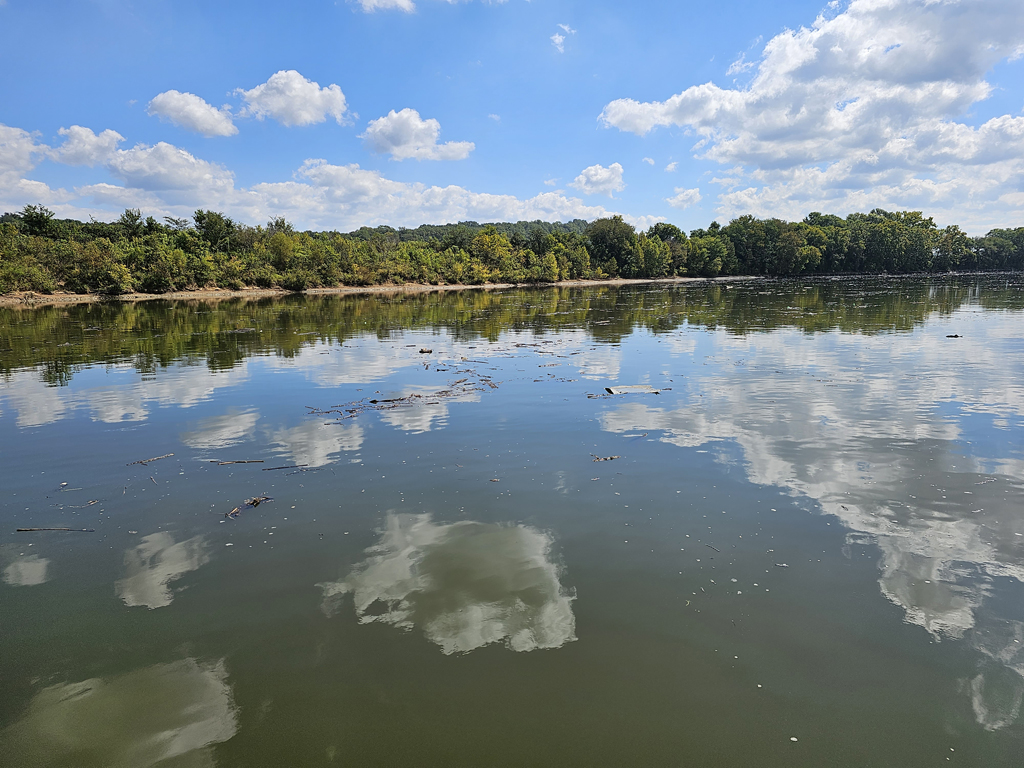

We tied up at Riverview Restaurant and Marina, across from Ashland, Tennessee, before 2:30. The dock has power pedestals and water outlets, but they were disabled and turned off. There was a Plan A and a Plan B for the night’s stop. Plan A was the restaurant that is known for its excellent catfish. Plan B was to anchor and eat on board. Dick phoned the restaurant a few days before, and was told that there is no dock any more. Boaters we met were astonished to hear that, telling us that they had docked there a few days/weeks earlier. We decided to go as far as the restaurant, and turn back to anchor if necessary. In the event, the 240-foot dock was there, with 20 feet of water depth and good cleats.
Dick checked out the restaurant, and after seeing that all the wines were from California, he asked about corkage. For $7, we brought our own bottle of wine for the meal. (I had a recent reminder in the form of a massive headache, that I am allergic to California wines, after we included the wine pairings at Freight House in Paducah, and one of them was a California white). It was a very good meal. We were not carded for the wine. Cheese curds with marinara sauce, not a usual offering this far from Wisconsin, and an interesting basket of baked pepperoni slices with ranch sauce for dipping were our shared starters. Dick did not care for the pepperoni, but I enjoyed the crispy, spicy, thin slices with the cool sauce. For the main course, I chose shrimp in New Orleans style barbecue sauce with grilled bread that was delicious. Dick opted to try a combo with 3 choices, the famous broiled catfish, a crab cake, and broiled shrimp. Paired with our own bottle of rose, the meal was well worth the stop. The dessert, banana pudding, was definitely homemade, and many would like it, but after one bite, I retired and left it for Dick.




As we approached the west side of Nashville the next day, we passed the Nashville Chew Crew, a herd of sheep (with a few goats) with a herding dog that hire out to clear overgrown land. The area is temporarily fenced, and the sheep graze it down, under the watchful eye of the herd dog. Just to remind us that we see something new all the time on the Loop! Later, Dick was able to ride his bike to their location, and get a closer view of the Chew Crew at work. His comment was that they represent a somewhat unexpected level of environmental sensitivity in what is still essentially a red-neck town!

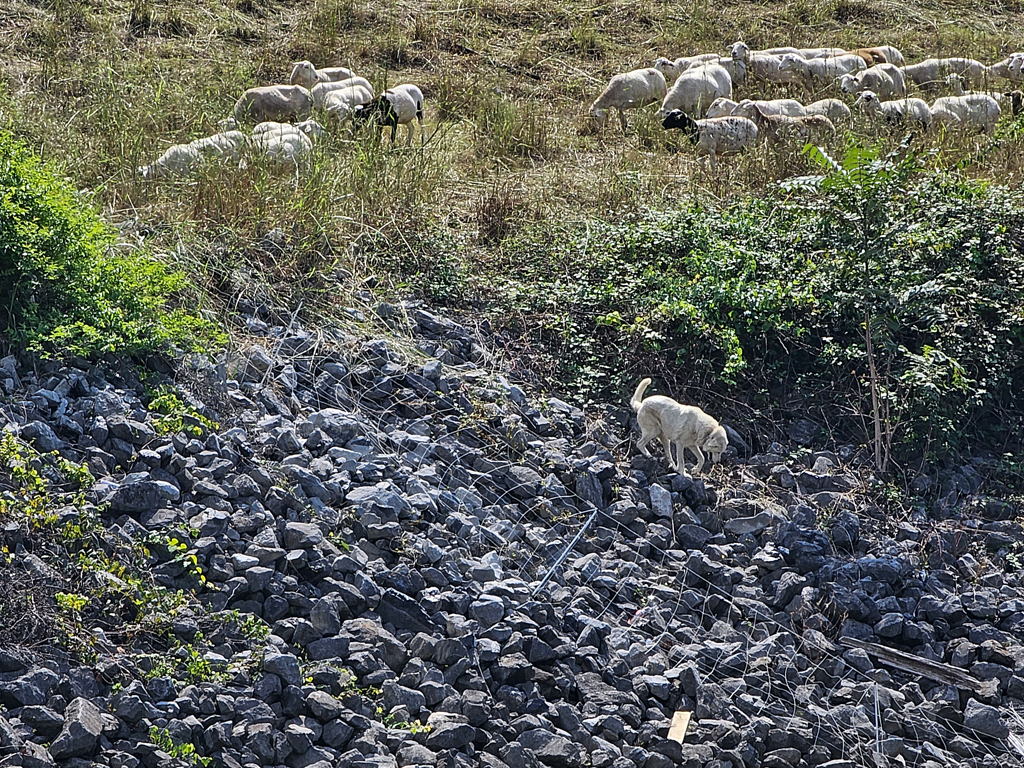


We were tied up at the City Dock by 1pm, across from downtown and American Melody that had arrived a day earlier. There was power on the docks, but strangely, no water, so we had to be careful of our usage. Just after we were set, a tow went past so fast that the dockmaster hailed him and told him off. We made a few adjustments to our lines to make sure other big wakes were not going to be snapping the lines.

After days of pleasantly cool weather, it was 85F. We knew we would have long walks to dinner across the pedestrian bridge on all three nights of our stay.
We walked across the bridge to downtown, and eventually made our way to Jeff Ruby’s steak house. Downtown was noisy, full of bars with live music playing loudly, and ugly characters standing outside as bouncers at the doors. I was reminded of Bourbon Street in New Orleans, with country rock instead of jazz (not that Bourbon Street has much jazz these days).
Dinner was excellent, in over-the-top surroundings, with piano music playing softly in the background. We were not carded when we ordered wine, fitting my expectation that fine dining restaurants would not do it. The law says if a person looks over 50, they do not need to show ID. Dick started with Oysters Rockefeller, and I had a shrimp cocktail, which was presented in a dish of ice lit from below by a blue light. The steaks were delicious and perfectly done. I tried mine with crab and asparagus on top. Dessert was a fat cigar-like roll, filled with chocolate ice cream, resting on an “ashtray” filled with pot de crème. Dick liked the cigar, and I preferred the pot de crème, so we were both happy.




Shortly after getting to sleep, Dick was woken by tapping on the hull. He got up and walked all around the boat, to see whether a stray log had become wedged and was banging against the hull (it was that loud). There was nothing to see. Eventually, he concluded that there were fish eating stuff off the hull. He had read about this, but we have never experienced it before. The noise was remarkably loud, and it moved from bow to stern and back and forth between the two hulls. It eventually stopped, but it was loud enough to keep us awake while the fish were enjoying their dinner. Catfish exacting revenge for their buddies that have ended up on Dick’s dinner plate?
The next day Dick explored the extensive riverfront bike paths, riding about 20 miles. He found the Nashville Chew Crew, hard at work, and was able to take more photos. I watched the pontoon tour boats arrive and depart for river tours from our dock. Later, three men asked me if we would mind moving along the dock. They were planning a combination car show (Porsche) and boat show (Chris-Craft) on the dock and the pathway above, and wanted to put their boats in our spot. Given that we had booked and paid for 3 days, and the dockmaster said nothing about moving, I told them that we would not be willing. When Dick got back from his bike ride he agreed with me, if we were to be moved it should come from the dockmaster, and we did not want to move anyway, for several reasons.
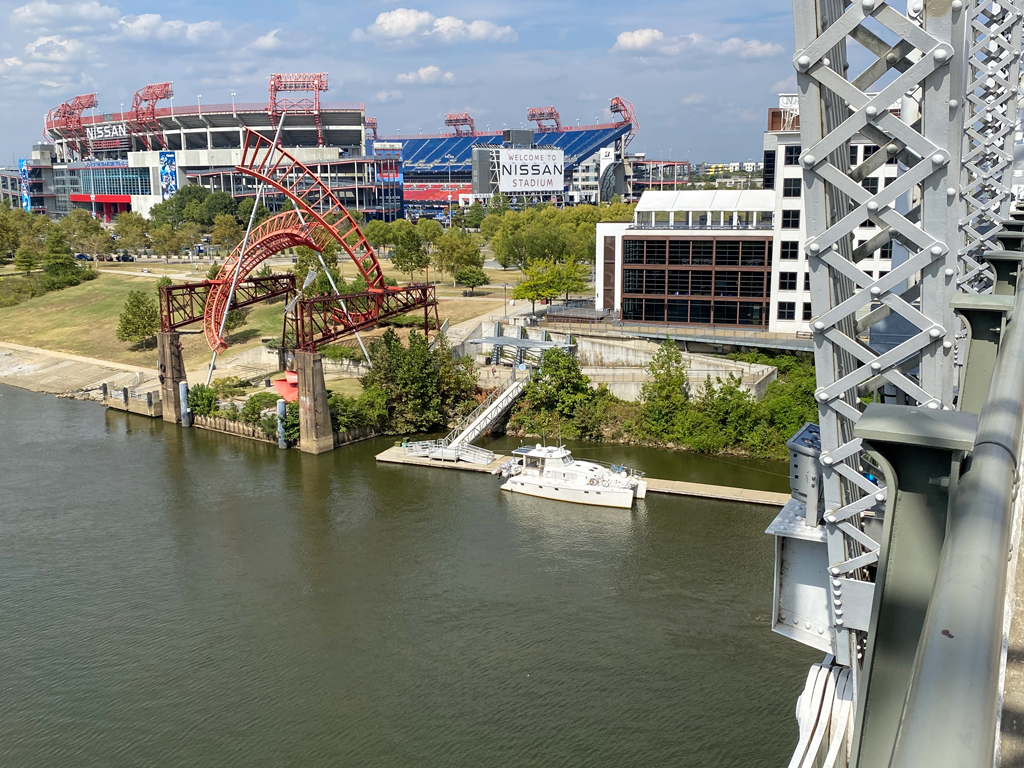

Jacques-Timothée Boucher, Sieur de Montbrun was a French Canadian, who, after the defeat of France at The Plains of Abraham in 1759, migrated to the British colonies in the south, and became a fur trader. He dropped his noble title, and anglicized his name to Timothy Demonbreun. At first, he lived in a cave, but soon built a log cabin near Nashville to be his base for hunting and trapping. He served as lieutenant governor of the Northwest Territory from 1783 to 1786 before settling permanently in Nashville. He is considered to be Nashville’s “First Citizen”. He built a fur trading and mercantile business in downtown Nashville, selling such useful things as window glass, paper, cured deer hides, and buffalo tongues. A man of his times, he maintained 2 families, one with 5 children by his wife in Illinois, and the other with 3 children by his mistress in Nashville. He died a very wealthy man, leaving his fortune to be divided among all of his children except one. His son, Felix, became a Baptist minister, and Demonbreun was a French Catholic, so Felix was cut out of the will. Neither his wife nor his mistress were provided for in the will either.

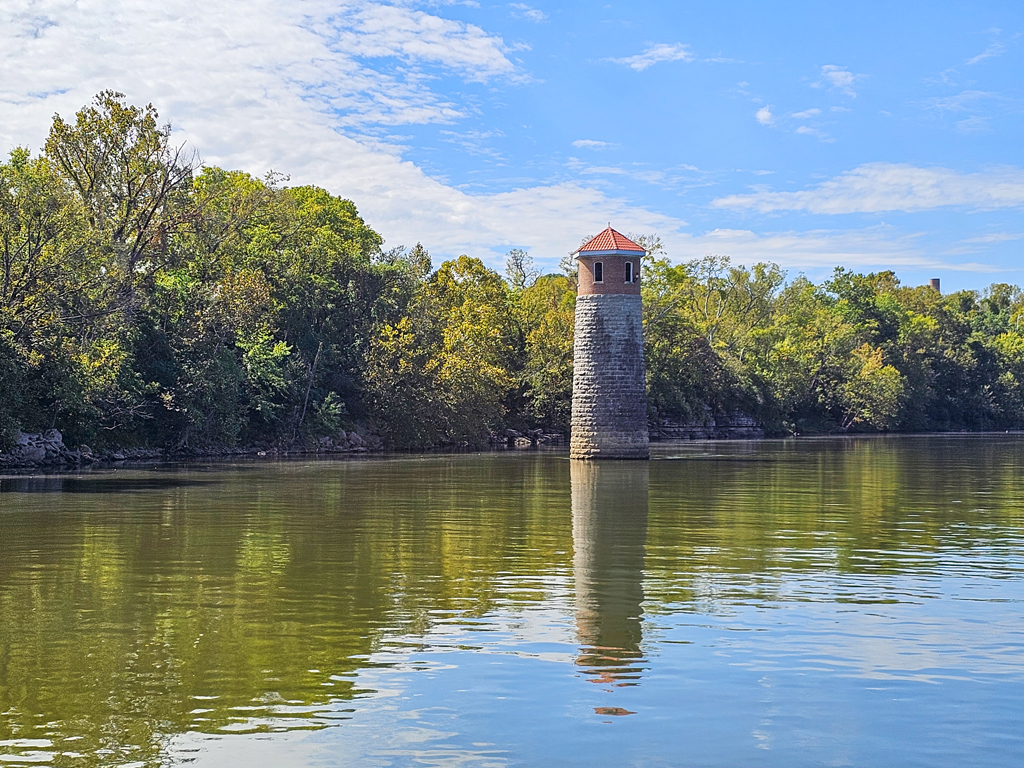
In 1929, The Seeing Eye, the world-famous dog training school was founded in Nashville. Morris Frank, a 20-year-old blind man, and his seeing eye dog Buddy co-founded the school with Dorothy Harrison Eustis after he read an article she had written about dogs being trained as guides for blinded WWI veterans.
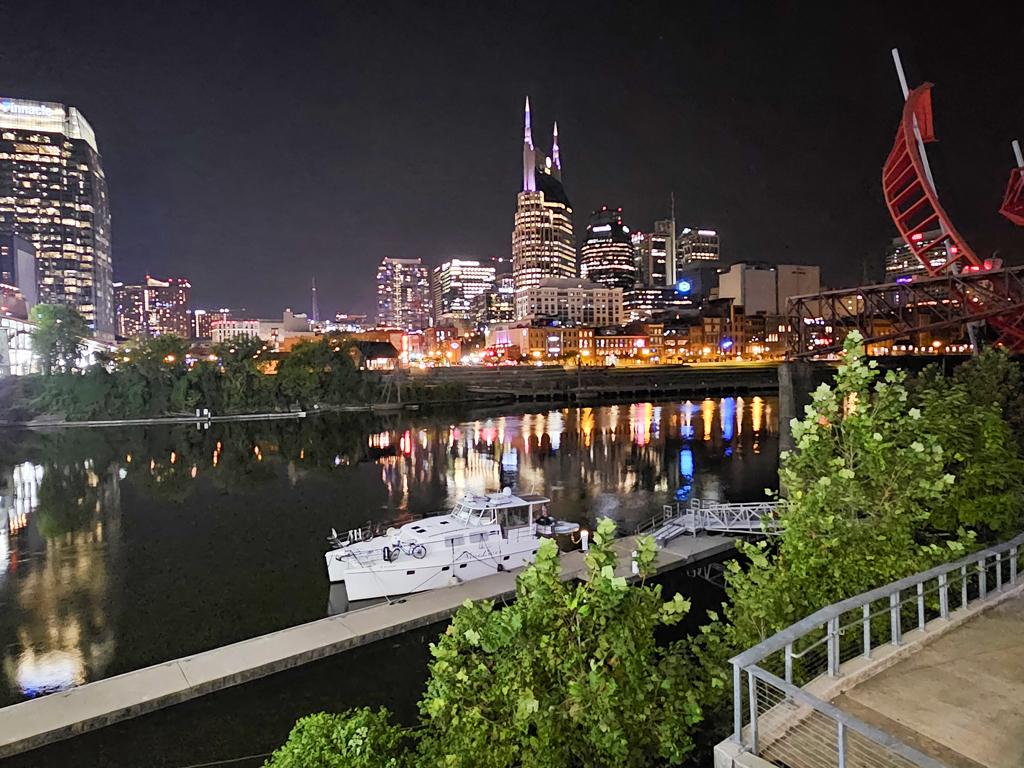
We walked across the bridge to Ella’s for dinner. This was a more casual venue than the previous evening, but the food was both creative and tasty. I started with a variation on prosciutto and melon, and Dick enjoyed his favourite beet salad. Dick made a better choice for the main course than I did, choosing the duck Bolognese, while I tried the black truffle gnocchi. I was glad that the waitress suggested topping my dish with grilled shrimp, as the gnocchi were not to my taste, although the sauce was delicious.
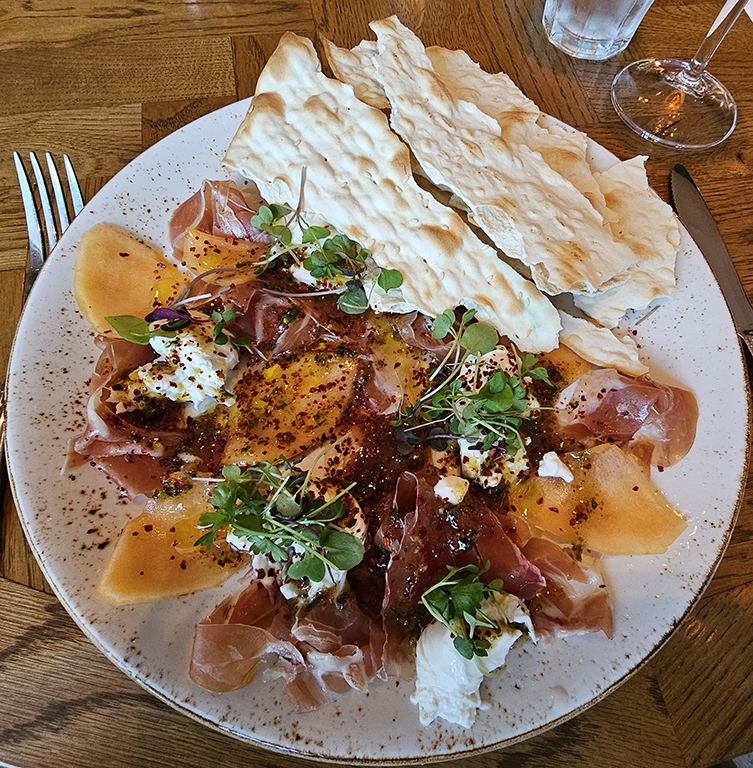
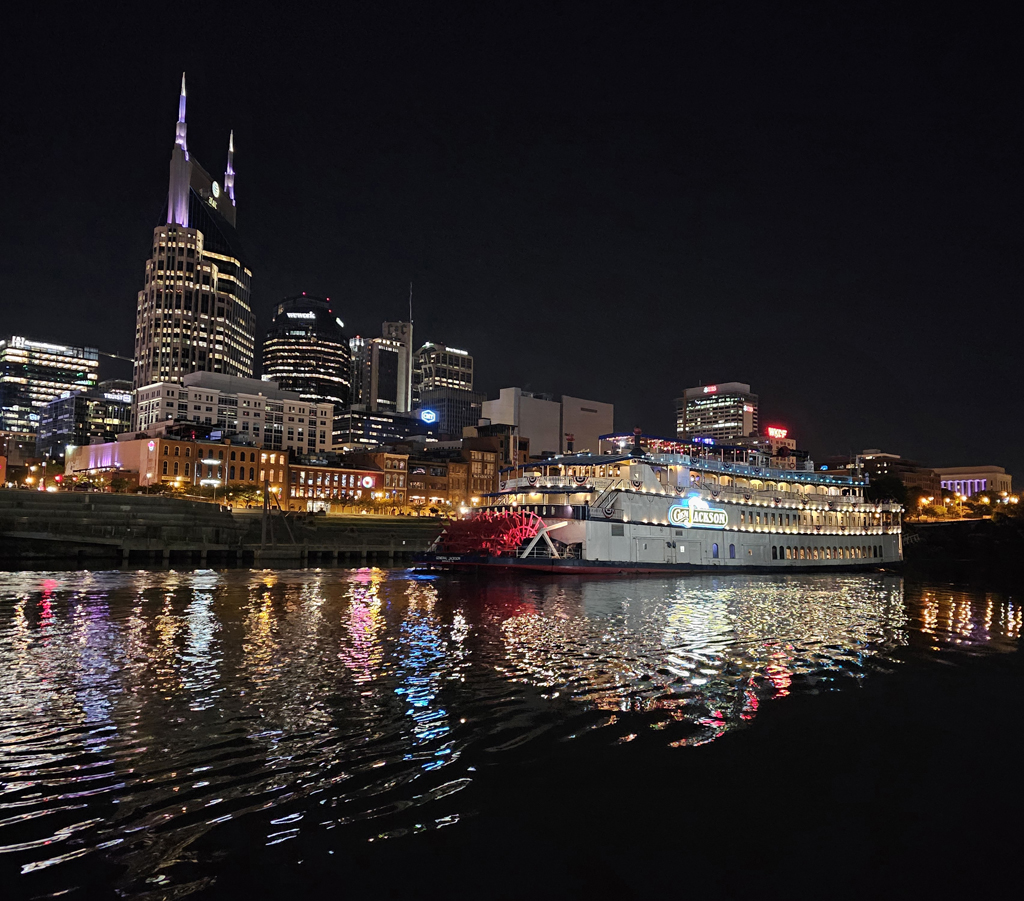
The next morning, we had booked a tour of the city on a hop-on-hop-off bus. When Dick downloaded the tickets, he discovered that he had made a slight error in the booking, and the non-refundable tickets were for the previous day. Fortunately, the very nice lady at the ticket office was willing to re-book the tour for the following week when we returned, so we did not lose out.
Dinner was at a modern Italian restaurant, Il Mulino, located in the Hilton downtown. Dick ordered octopus to start, a beautiful and delicious presentation, but I have chosen not to include a photo to spare the sensibilities of some of my readers! I ordered the Caprese salad, very pretty, and quite acceptable but the balsamic was overly sweet for my taste. The chef would seem to be anti-salt, as my shrimp dish was bland, and I had to ask the waiter to bring a salt shaker. The first one was empty, suggesting that I am not the only customer who felt the need to use it. Dick loved his lasagna, a huge serving, so he chose to take half of it home. We shared a delicious, elegant, and perfectly sized flourless chocolate concoction for dessert.


At the next table was a couple, he with baseball cap firmly in place, and she apparently having been over-served at the bar. They ordered pizza, and asked for a box before even half was eaten. At this point, she put her head on the table and went to sleep, while he sat quietly, contemplatively eating slices of pizza from the take-out box, while occasionally patting her arm. To us they were sadly the epitome of Nashville visitors.
The Shelby Street Bridge, now called the John Seigenthaler Pedestrian Bridge, spans the Cumberland River above where we were docked. It was built in 1909, and was one the first in North America to have concrete arched trusses. After just 25 years, there were problems with the concrete, and the bridge was repaired over a two-year period. Thirty years later, it was in need of further repairs. It finally closed in 1998 because it was unsafe after years of heavy traffic. Instead of tearing it down, the city decided to convert it into a pedestrian (and cycling) bridge. Four years and $15 million later, it opened in 2003. It is 3150 feet long, one of the world’s longest pedestrian bridges. There is lots of seating, and several viewing areas, and each night we were there we saw a different busker.
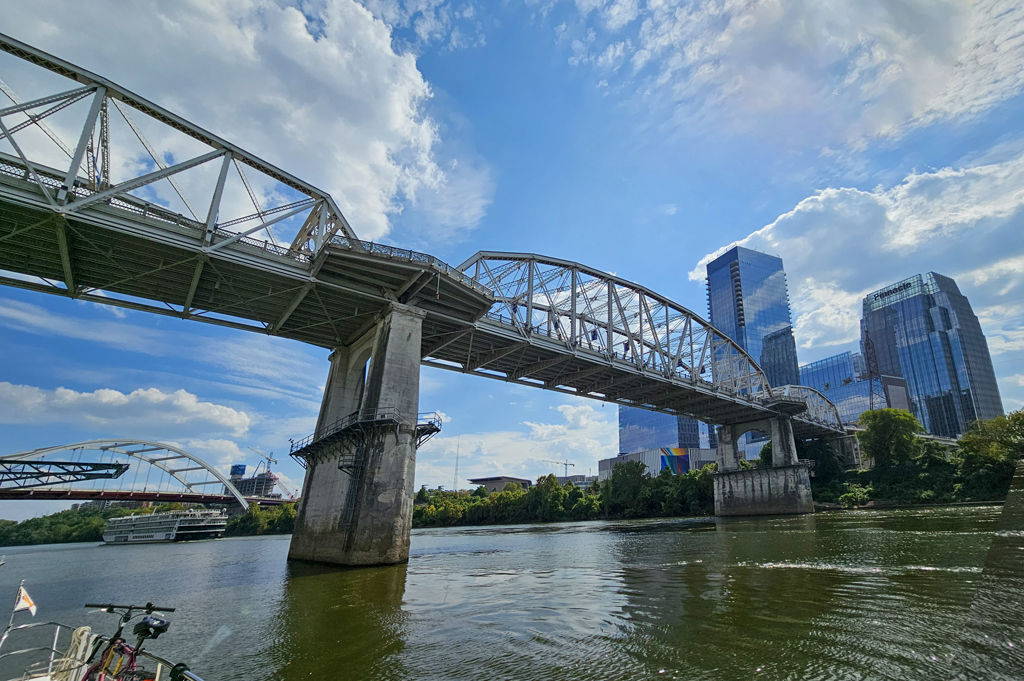

As we crossed the bridge to return to the boat, we realized that not only was the busker that evening excellent, he was singing Turn the Page by Bob Seeger. It happens to be one of our favourite songs. It has also been covered by Waylon Jennings, and others. The busker was singing it very well, all the poignant emotion of a musician, tired of being on the road, was conveyed, and all that was missing was the wailing sax of the Seeger version. A perfect end, and very positive, for our first stay in Nashville.
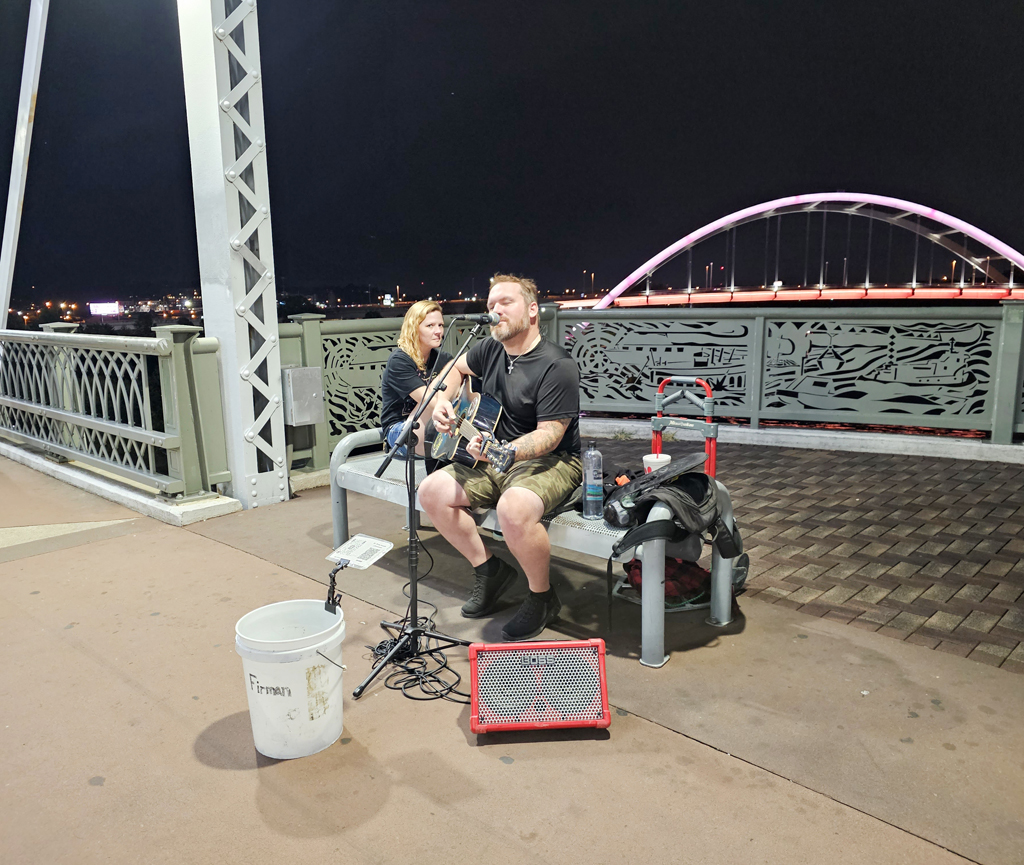
The General Jackson Showboat is one of the largest showboats ever built. It was launched on the Ohio River in 1985. It plies the waters of the Cumberland River from Opryland to south of Nashville, with both lunch and dinner cruises. Each cruise includes a show in the two-story theatre. I had wondered whether the boat is a true stern-wheeler, or whether the paddlewheel is just decoration. Fortunately, I married an engineer (and have brought him with me on this voyage), who can interpret the information given on the website. The engines are 2 Caterpillar 3512’s, 1050hp per engine, and 880 kw generators. The engines will drive the generators, and the generators will drive the 2 600hp GE motors to turn the paddlewheel. Dick believes that there will be no propellers with that configuration, so the boat is a true sternwheeler.

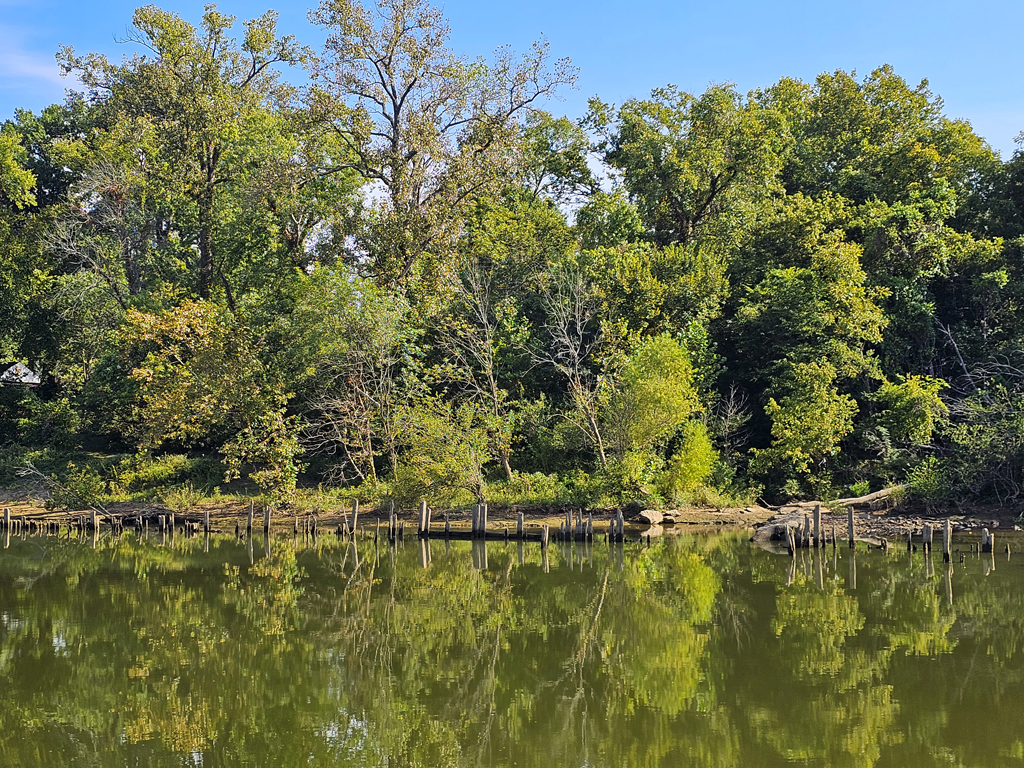
The Cumberland River gets quite narrow below Old Hickory Lock, with a rock bottom that had to be blasted to build the waterway. It was very important to “colour between the lines”, that is, stay between the markers, on this stretch of the river. We hoped we didn’t have to meet or pass a tow.

We had a 3.5 hour wait at the lock. It was unfortunate that we arrived when they were putting through 2 downbound tows, one of which had to triple split, as the lock is very small. We had planned to anchor that night, but given that it was a weekend on a busy lake, Dick called one of the marinas he had not tried earlier, to see whether they had room for us. They did, in a 20×50 slip. We made our way up Drakes Creek, past incredibly large houses, to Creekwood Marina. There we spent half an hour tooling up and down the various piers (none of which had numbers or letters), trying to find slip D20. The map the nice lady had sent didn’t seem to have any relationship to the empty slips we could see. We even called out to some people on their boats, but they could only direct us to D-Dock, and we still couldn’t find our slip. The lady tried to help us on the phone. Half an hour of appearing increasingly suspicious to boaters in their slips, and Dick discovered that we were in entirely the wrong marina. The one we had booked was ten miles up-river, once we had made our way back to the main Old Hickory Lake. Altogether we lost at least another hour in a day that had started just after 8am.
I did at least get to take a picture of Rock Castle, and we saw some amazing houses. Apparently, many successful people in the Nashville music business, both artists and executives, choose to live in Henderson, which is on Old Hickory Lake across from Greater Nashville.

Daniel Smith, a Virginian Surveyor, began construction of Rock Castle in 1784. The house sat on part of the 3,140 acres that Smith received in land grants for his service in the Revolutionary War and his surveying work. The family lived in the house for over 200 years, and it is considered to be the oldest house in Middle Tennessee. It was always very well kept, and is still in similar condition to its original state. Smith was an Indian negotiator, negotiating most of the treaties with the Cherokee Indians in Tennessee. He drafted the State Constitution for Tennessee, and was also one of the earliest Senators, serving two terms when Tennessee became a state. The mansion was built from rocks quarried on site. The stone construction led to the myth that the building was fireproof and it began to be called a castle.

Once we had left Drakes Creek and were back to the lake, Dick decided to kick up the speed, so we arrived at Cedar Creek Marina just after 6pm. The marina map now made sense, and we found our slip. Fortunately, there were 2 resident boaters on the docks, who came to help us get in. I say fortunately, because we got partway into the slip and came to an abrupt and sadly familiar halt. Not a 20-foot-wide slip! In fact, it was 17.5 feet. The mistake was that the marina measures the distances between slips, without accounting for the finger pier between. It was after hours, so we could have been without a place to go except for anchoring. That was no longer a good option, because, expecting to be in a marina, we had not filled up with water after the lock, and our water tanks were nearly empty. The resident boaters knew about an empty houseboat slip, and they directed us there (and helped tie up). This one was 25×80, so no problem with the fit! The frustrations of the day were not over. Once we were set and tied up, Dick attached the power cord to the 50amp outlet at the end of the slip. No power. We had to untie and move the boat further into the slip, and then use the outlet across the dock with a single 30amp socket. This meant using power management on board, being careful, for instance, not to use the toaster oven and any AC at the same time. It was after 7pm before Dick had retrieved the keyfob to access the showers that had been left for him and we sat down with a very large Manhattan to finish an 11-hour day. The distance to the showers meant that there was no possibility that Dick would use them, and yet he had to walk over there the next morning to return the keyfob.
We had a very peaceful night, and enjoyed chatting with our friendly slip neighbours. We were out after a leisurely morning by 10:30, ready for a day of sightseeing around Old Hickory Lake.
We had made a change to the original plan. We had expected to be in Drakes Creek the first night, and then anchor at Bledsoe Creek, at the farthest we planned to explore, the second night. It would then be about a four-hour journey back to the lock. After our experience waiting, and studying the movements of the 2 tows that travel back and forth every day between Nashville and the Gallatin Steam Plant, we realized that we would be better being as close as possible to the lock for the second night, anchored in a location that we could stay as long as necessary (we now know that 6-hour waits for that lock are common), and be ready to pull anchor and get to the lock quickly when the opportunity came.
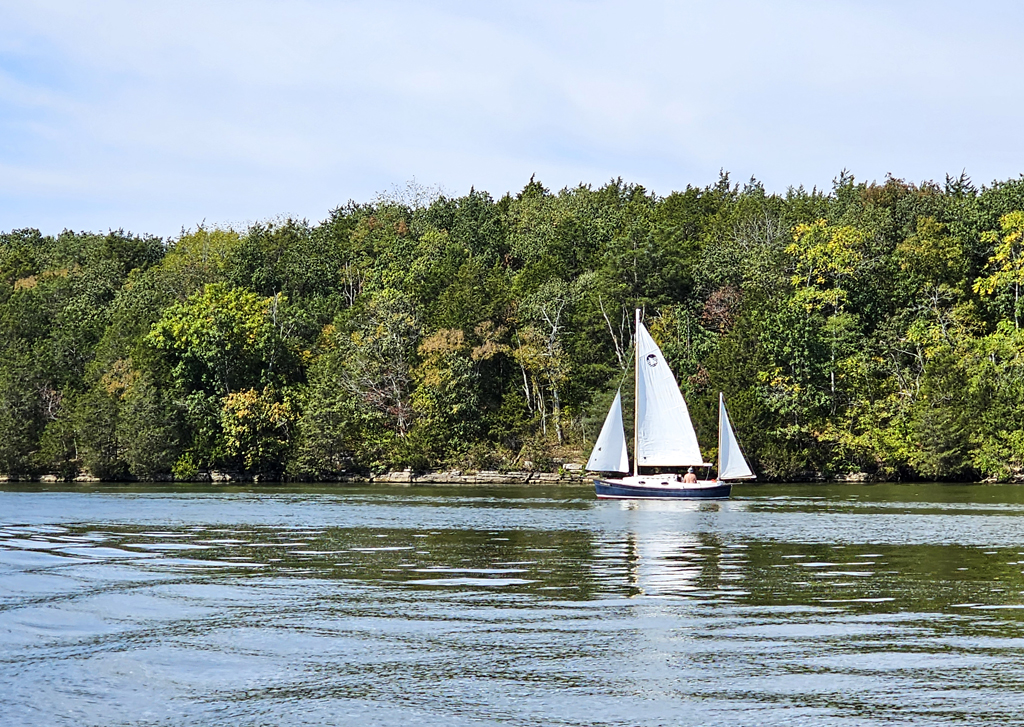
We liked Old Hickory Lake. Other boaters had made faces and told us to go further upriver, to Cordell Hull, above the next dam. One boater’s comment was, “It’s all houses.” However, we enjoyed the mix of houses, some very large, and some quite modest cottages. There were plenty of quiet and scenic areas, especially as you get farther from Nashville and Henderson. The fall colours were just starting.
We passed Seven Mile Bluff, with trees turning to gold for autumn.
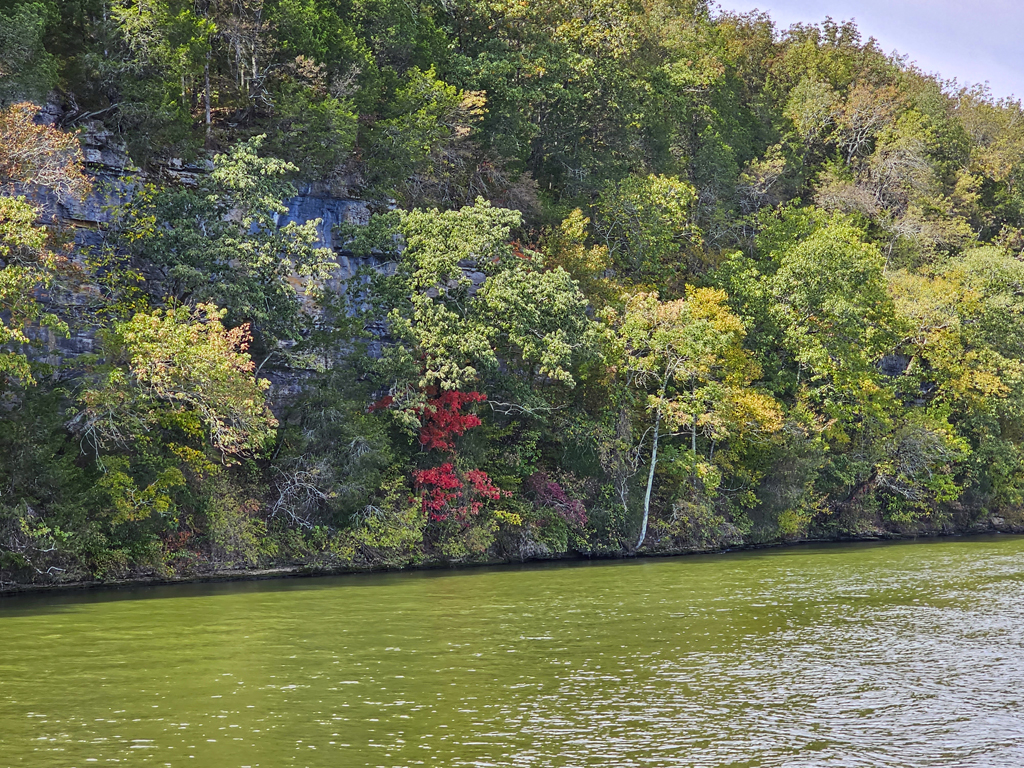
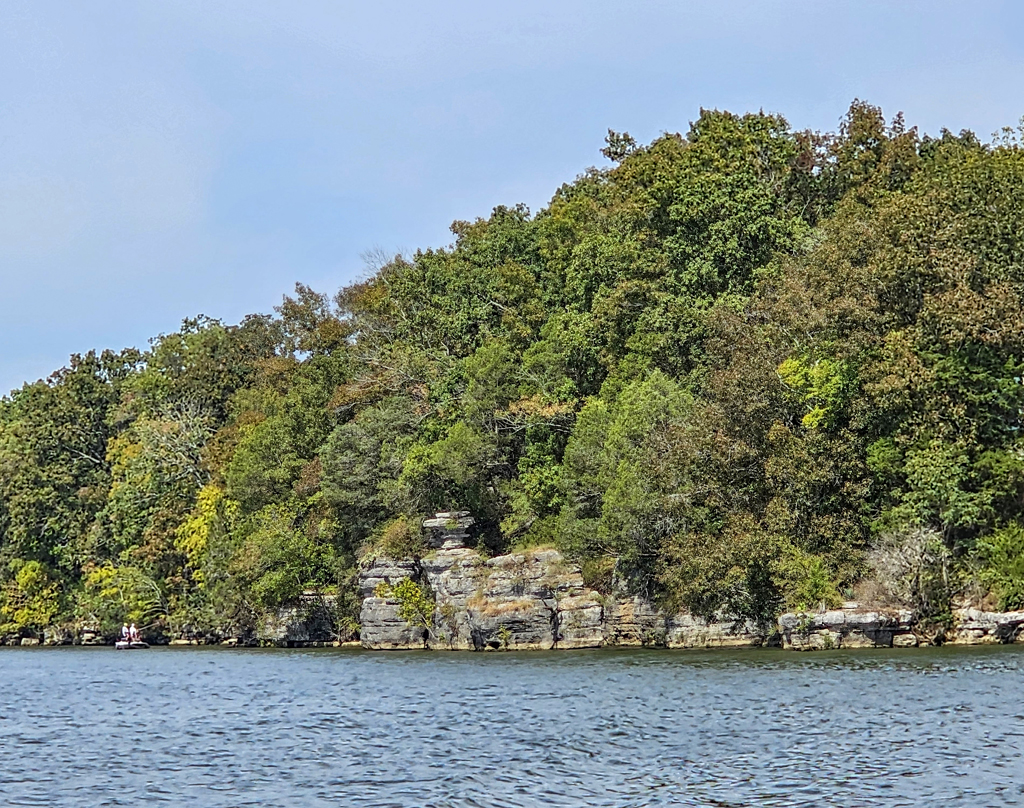
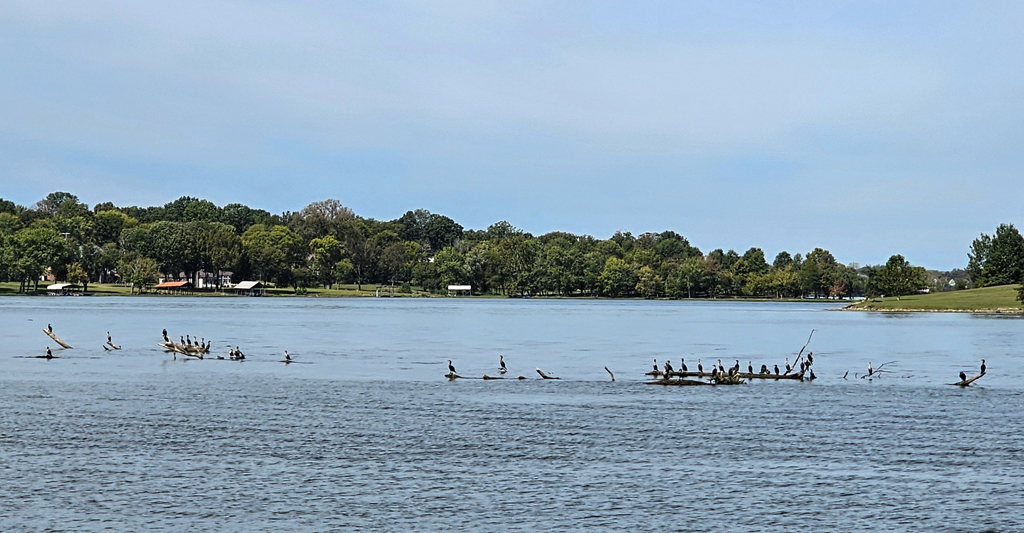
We went as far as Cairo, and saw what we think is the only house remaining from what was an important city until the railroads and better transportation links made it a ghost town by 1855. The city was originally called Ca Ira, usually translated as “It will be fine”. Ca Ira was the song of the French Revolution, and given the French roots of the earliest settlers and the voyageurs and fur traders in this area, the name makes sense. The city began growing in the late 1700s and early 1800s, and was one of the largest shipping ports on the Cumberland, rivalling Nashville in importance. When another city was chosen as the county seat, coinciding with a decline in river traffic and an economic recession, the city disappeared.

We passed the house where Johnny Cash and June Carter Cash lived from the 1960s until 2003 when they died. Many of Johnny Cash’s songs were written in this house. It was bought by Barry Gibb (Bee Gees) and burned to the ground in 2007 while under renovation. The property has recently been purchased by a hedge fund manager for $3.5 million.
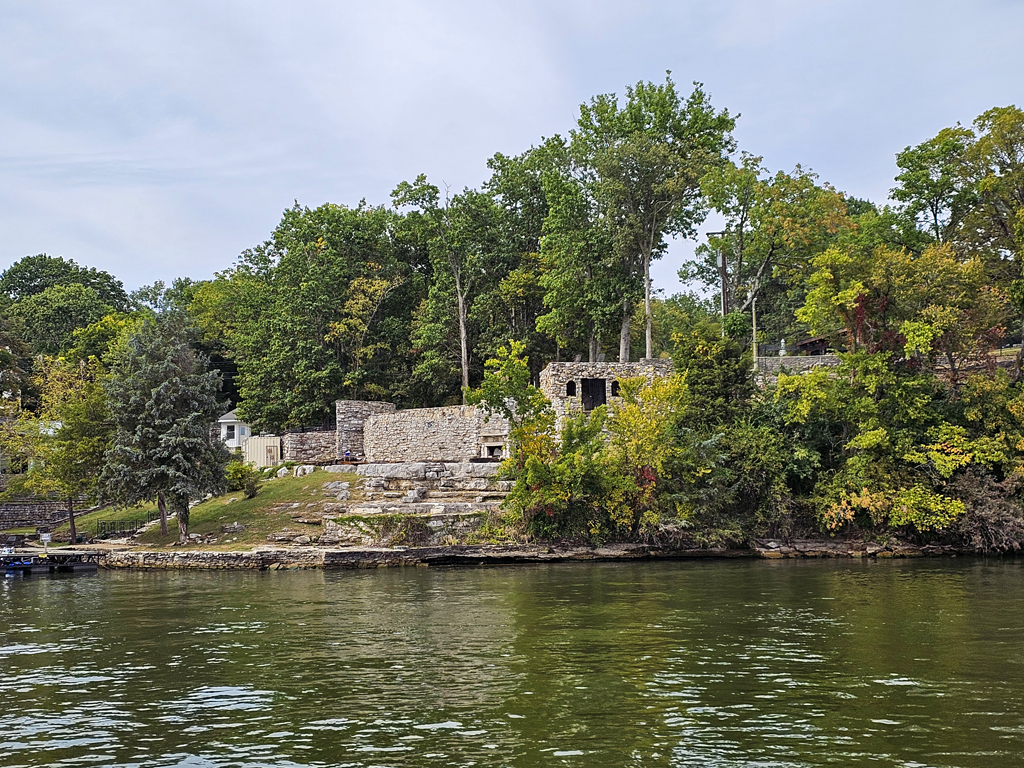
We anchored for the night across from Walton Ferry Arboretum, set by 4pm. We were very near the lock, and planned to set an alarm and check the lock queue status. At some time in the middle of the night, one of the 2 tows that monopolize the lock, arrived above the lock and was in place to go down by 6am when it opened. Dick called the lockmaster, who predicted (with no promises) 9am for our transit. Meanwhile it was a very peaceful anchorage, with a glorious sunrise and good cell service, so what more could we ask for while we waited!
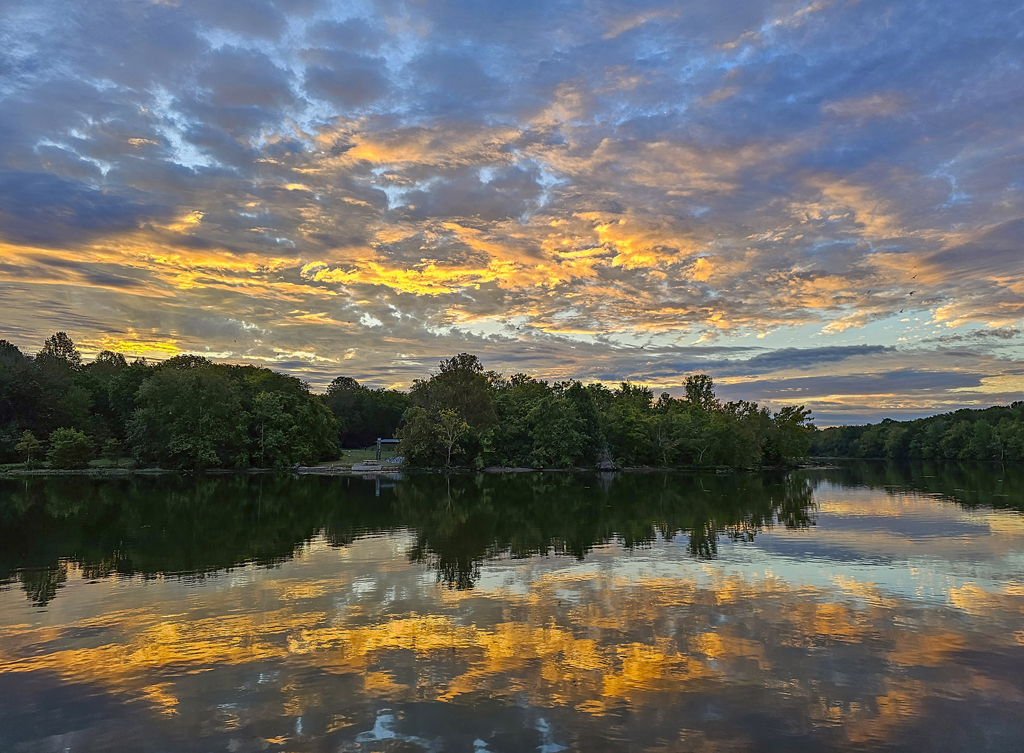
We were into the lock just after 9am, but it was a bit of a debacle. I could not get Nine Lives over to the port side of the lock while Dick was waiting to put the line over the floating bollard. After 2 unsuccessful tries, we switched roles, and although Dick did get the boat into the side, I couldn’t get the line on the bollard properly, so we had to scramble and return to our usual places. Fortunately, Dick snagged the line and was able to get it secured. He agreed that there was a strong current pushing us away from the wall, even though there was no wind, so I felt vindicated!
A night heron sat on the lock door and watched us descend 60 feet. We were out of the lock well before 10am, and on our way to Nashville. We passed the Municipal Dock, and waved to Dock Holiday, a Looper boat tied there. They later sent us a very nice picture of Nine Lives passing through. We arrived at Rock Harbor Marina, and after getting a pump out, we were in our slip by 2:30. We looked longingly at the empty slip next to us, thinking that it would be less in the hot sun than ours. It was 86F. However, we later realized that most of the slips are in bright sun, so moving would not gain much.

We went to the onsite (highly rated) restaurant for dinner. It was something of a mixed experience. It is fully outdoors, never my favourite option, and the food is mainly burgers and baskets, although well-presented. The cheese curds we started with were delicious, a generous sharing portion, and served with two sauces. Dick ordered the Mahi mahi with a side of broccoli, but the waitress misunderstood and he received the sandwich option instead, which was a bit odd with the broccoli! Apparently, the sandwich was good anyway, as was the broccoli! I ordered nachos with BBQ chicken. It was not at all what I expected. The chicken (which was very good) was grilled white meat, cut into pieces, and real cheese had been used, but the whole plate was slathered in sweet BBQ sauce from a jar.
When we got back to the boat, I discovered that the swim platform was considerably further from the dock than I am comfortable stepping across. Dick always dismisses my concerns, telling me to just let myself fall forward onto the step. Yeah, right. As I hesitated and tried to gather the courage to make the jump, some other boaters stopped and offered to help. We explained that it was just a matter of getting enough courage to jump, but one guy was really concerned, and insisted on waiting until he knew I was safe. I told him he could help fish me out if I fell into the drink! It was a very touching example of the care and camaraderie that exists among boaters!
The next day, Dick picked up the rental car and did a supplemental grocery shop. Dinner was at Chateau West, a very nice French restaurant. The food was delicious. Shrimp in saffron sauce for me, while Dick ordered escargot, carrying on his search for an authentic version of the French delicacy. This time, there was still not enough garlic, and a lightly vinegary sauce, but acceptable. I ordered filet in perigourdine sauce with mushrooms and scalloped potatoes. Dick’s choice was duck in Chambord sauce. As Dick’s second glass of Beaujolais was delivered, he tried to help the waitress by tossing back the last mouthful of wine in his first glass. Too late, I noticed that there was a lot of sediment in the glass. “Ghaak!” was the gist of Dick’s remarks, followed by downing a lot of water.
Dessert for me was Isle Flottante, a seldom seen concoction of soft meringue islands, floating in crème anglaise (which, of course, being English, I call custard). It was delicious, even with the somewhat untraditional addition of caramel sauce and slivered almonds, but it was enough for 3 people! Dick had Poire Belle Helene, also very nice. As he commented, in this country, the chef will seldom have access to properly ripe pears, so the dish was not quite as it should have been, although very close.
An interesting observation – our waitress had a familiar accent, so Dick asked where she was from. The answer was Russia, specifically Siberia. They were able to chat about places that Dick had visited during his career. The hostess, who also helped out with water, wine, and bread, and delivering food, also had a familiar accent. When asked, she told us she is from Ukraine. This cannot be uncommon, and must in many ways be difficult for these young ladies, but on the other hand, it shows that ordinary people just get on with their lives, regardless of the politics of the moment.
We were not carded in this restaurant, as with everywhere in Nashville, but Dick noticed that a younger couple at a nearby table were asked for ID. This is how it is supposed to be, according to the new Tennessee law. It appears that the cheaper, high volume, and especially chain restaurants just make it a blanket rule for their staff, and assume nobody will care enough to give negative reviews.





On our return, Dick was in dog-heaven, as we met the English Mastiff with her small doggie companion and her person. Dick was able to pet the Mastiff, and reminisce about our Hannibal, long departed. The couple hope to do the Loop after retirement in a few years’ time, so perhaps we will meet them again.
September 27th. A busy day for our last in Nashville. In late morning, we went downtown and got on the hop-on-hop-off bus tour. We had 2 different drivers. The first was a real Tennessee Southerner, quite a character. He told us all about local food and where to eat it, spiced with anecdotes from his life. The second driver was a young guy with a somewhat dry, but much more informative presentation with respect to the monuments, architecture, and Music Row. We enjoyed the trip, and it was the best way to see the city.

Next, we visited the Country Music Hall of Fame. It was very interesting, and we enjoyed it, but we felt that there were quite a few gaps in the overall story. In the inevitable comparison with the Rock and Roll Hall of Fame in Cleveland, which we also visited on the Loop, this fell short. One whole wall of one floor was dedicated to the story of an artist neither of us have ever heard of. We couldn’t figure out why he deserved so much attention.


After a pick-me-up pause in the bar, and a cruise around the gift shop (we didn’t buy a guitar), we headed to our final venue for the day, The Listening Room. Here we enjoyed a dinner show that featured 4 singer-songwriters who took turns to perform their own compositions. All were good, but we would have preferred to have heard at least some familiar music. Also, all were men, and we generally prefer the women of country music. The food was quite good, of the burgers and baskets style, but we noticed that we were one of the very few tables to order a meal. Most people just shared appetizers and ordered drinks.

Both of us were up at 5am the next day, as a thunderstorm crashed overhead. We were in a covered slip, but the rain did come in, and by the time we had zipped up the windows and closed the upper hatch, we were both wide awake. There was not going to be any more sleeping through the thunder and lightning anyway.
It was an unexpectedly wet day. Dick had to step outside and get damp to put in the eisenglass side doors. It rained on and off as we approached the lock.
My marine traffic app showed only one tow anywhere near the lock, and he had been stationary for hours. As we got close to the lock, Dick made his usual phone call, and was given the bad news that the tow we could see was next, and there were 2 upbound tows waiting. This could easily have meant a 9-hour wait until it would be our turn, as all 3 waiting tows were going to have to split to go through the lock (a split tow will usually take 3 hours, and that is often an optimistic estimate). The lockmaster told Dick that the electric company had wanted to generate some electricity, so they had held back the dam, and as a result, it became too shallow below the lock for tows to go through. This resulted in a queue. Dick agreed to be available for contact, and we continued past the waiting tow, planning to wait just above the lock in case the lockmaster could sneak us through. The tow we passed, that was next in line to go down, did not untie, and he was a good half hour before he could get up to and into the lock, so the lockmaster just opened the doors for us as we approached. Dick commented that, as always, he would rather be lucky than good! However, some of that luck did not continue. After choosing not to put on his rain jacket, while Dick was tending the line as we locked down, the heavens opened, and he got very wet.
Below the lock we came upon a tow that was diagonal across the narrow river. He hailed us, and told Dick that he was “kinda stuck here”, and suggested that we should pass on the 1 whistle (port to port) where we would have deeper water. In his diagonal position, there was no way the tow behind us could pass him. A coastguard announcement was made that there was a tow aground in that spot. Half an hour later, another announcement said he was no longer aground, so he must have been able to free himself and get over to the cells to tie up and wait for the other tow to go past.

We arrived in Clarksville and were tied up by 2:10. There was one other Looper boat on the dock, plus the Harbor Hosts, Two Hull-Areas in their usual slip. Dick chatted with Dock Holiday, learning that they were the folks who sent us the great picture of Nine Lives passing downtown Nashville when we passed them on the Municipal Dock. They had been just about half an hour ahead of us at the lock, and heard all the conversation with the lockmaster. We are looking forward to docktails with them and Gina and Roger from Two Hull-Areas this evening.

Here’s some music trivia for you.
One cannot visit Clarksville (if you are part of our generation), without thinking about the song, “Take the Last Train to Clarksville”. In fact, it’s something of an earworm. The song was written in 1966 for the Monkees by Tommy Boyce and Bobby Hart, but the only member of the band who participated in the recording was Micky Dolenz, who sang the lyrics. The song is a plea from a man to his girlfriend, to meet him in the city so they can enjoy a last night together before he leaves. Although it is not specifically mentioned, the presumption is that he is going off to war “and I don’t know if I’m ever coming home”. It is usually interpreted as an anti-war protest song. Clarksville is near Fort Campbell, Kentucky, the home of the 101st Airborne Division that was then serving in Vietnam. Unfortunately for generations of English teachers who study the song and get their students to analyse the lyrics, the song was not written about Clarksville, instead, a town in Arizona called Clarkdale was chosen, and then the writers decided that Clarksville sounded better. Looking into the song further, you may remember that the Monkees were not originally a band of musicians. Instead, the TV producers wanted to cash in on the popularity of the Beatles and their successful films. They advertised for singers to act in a comedy TV series. Many of the original recordings did not feature any of the band members, instead they used studio musicians and singers. The Last Train to Clarksville was inspired by the Beatles’ “Paperback Writer” (there’s another earworm for you), with a similar style, tempo, and a distinctive guitar riff. When Hart first heard Paperback Writer, he misheard the ending, thinking that Paul McCartney was singing “take the last train”. Yes, that is the story, and if you are familiar with both songs, you must be wondering, as I do, what substances he had ingested before listening! Once he found out the those were not the lyrics, he was free to use them, and Hart set them as the base for Last Train to Clarksville.


